Shu LinKou Air Station Tour: 1975 to 1977
The Last Days of Linkou
Updated 08 October 2016 / Added 08 May 2009
Shulinkou Air Station photos from 1976 through its closing on April 01, 1977.
Shots of Dawg Flight "moving out" of its barracks days before the base closing.
(Click Here) February 23, 1977 Shulinkou "Devil Dog" Base Newspaper, special commemorative final edition is located below.
Please send us an E-Mail (Click Here) for any corrections, questions, or comments...or to send us your photos.
Shulinkou Aerial Photos and Map
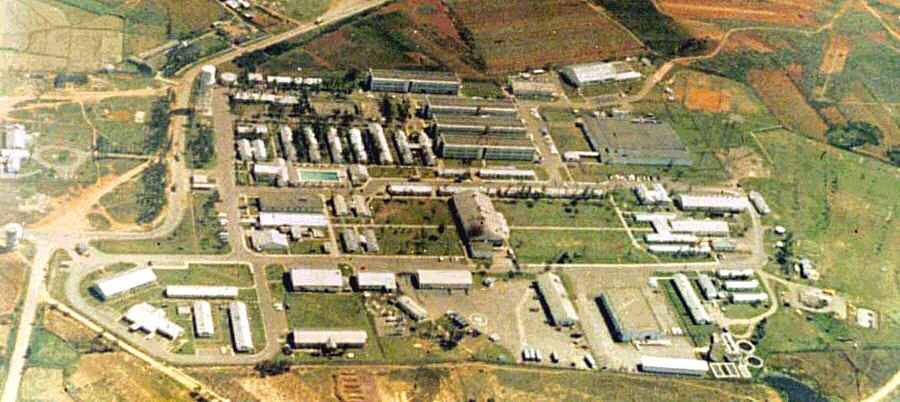
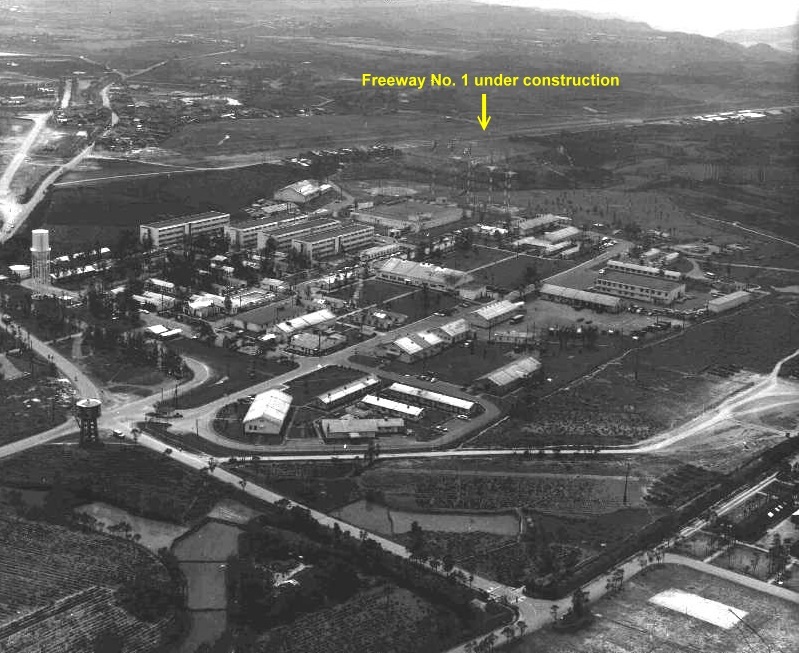
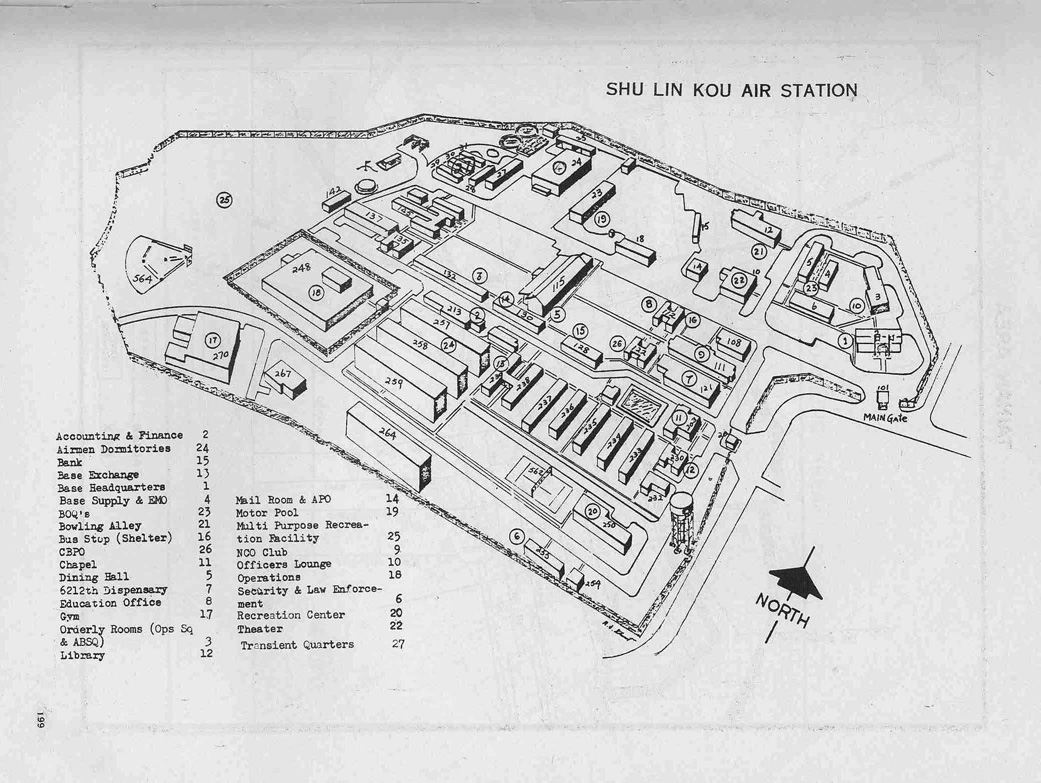 Shulinkou Air Station 1970 Shulinkou Air Station circa 1974 Base Map 1974
Photo credits: (1.) D. Bechtel (ASA: 1968-70). (2.) Unknown. (3.) 1975 "US Forces Taiwan" phone book, provided by L. Duffin.
(Click on Photos to Enlarge)
Shulinkou Air Station 1970 Shulinkou Air Station circa 1974 Base Map 1974
Photo credits: (1.) D. Bechtel (ASA: 1968-70). (2.) Unknown. (3.) 1975 "US Forces Taiwan" phone book, provided by L. Duffin.
(Click on Photos to Enlarge)
Main Gate, Headquarters, and Main Street
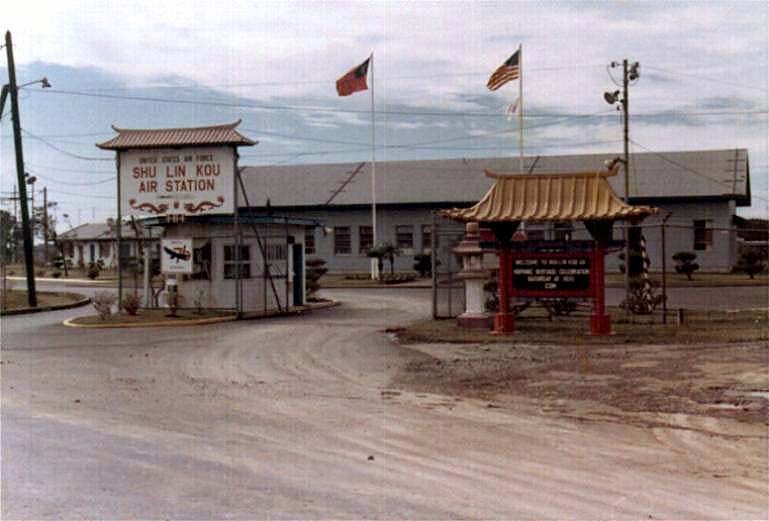
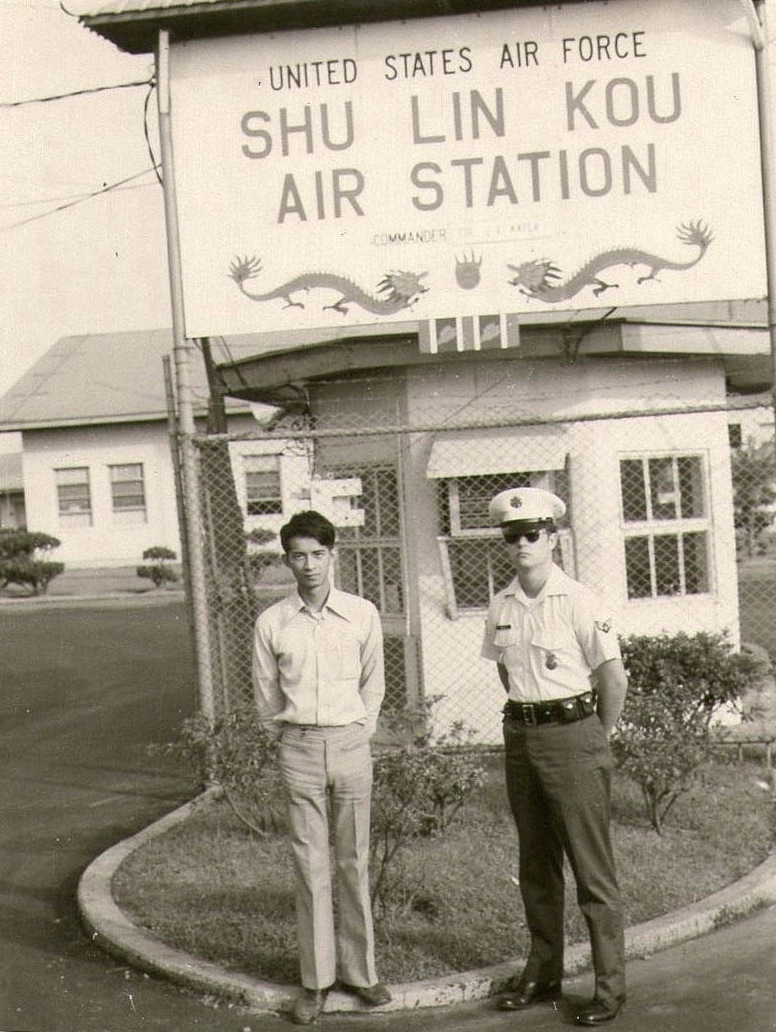
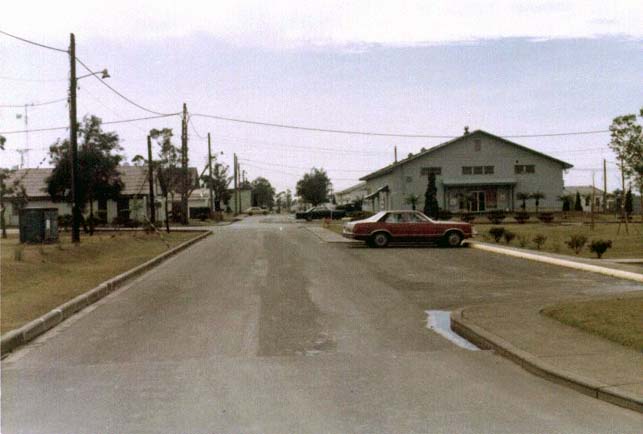
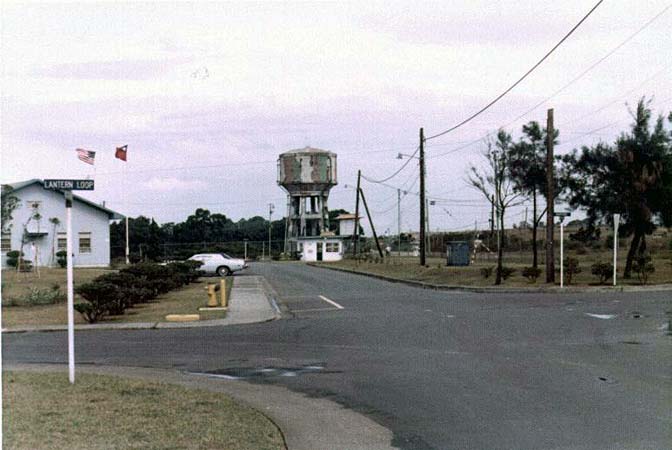 (Click on Photos to Enlarge) Photo credits: (1., 3., & 4.) Al Budington (1976-77) (2.) Wen Hsiao (Shulinkou 1976)
(Click on Photos to Enlarge) Photo credits: (1., 3., & 4.) Al Budington (1976-77) (2.) Wen Hsiao (Shulinkou 1976)
1.) 1976 shot of the Main Gate, Headquarters, and BOQ (far left). The large red and gold sign to the right of the Main Gate was added sometime after 1973. The "76" and eagle placard below the "Shu Lin Kou Air Station" sign on the Guard Shack signified the 1976 Bicentennial celebration in the states commemorating the 200th year anniversary of the founding of the United States. The Bicentennial flag flies below the U.S. flag in front of Headquarters.
2.) 1976 photo of Wen Hsiao, ROC foreign affairs military policeman (MP), and Sgt. Gary Smith, USAF Security Police, outside the main gate. (Wen Hsiao served with the ROC MPs at Shulinkou Air Station during 1976.) Headquarters and the BOQ (far left) are in the background. Colonel James E. Kater (name on Guard Shack sign) was the Shulinkou 6987th Security Group Commander from 1974/75 to March 1977. Lt. Colonel Carmen T. Scarpino was the Base Commander.
3.) The 1976 view looking west down Shulinkou's main street from just inside the Main Gate and standing adjacent to the Headquarters building off to the far right. The base Movie Theater is on the right. The building on the left (bldg. 108 on base map above) across from the Theater housed the Linkou Club administrative offices. The Linkou Club was located next door and is off to the left of the photo.
4.) The 1976 view from the front of the Theater standing on the corner of "Lantern Loop" and "Main Street" (see street sign-left foreground) looking east towards the Headquarters building on the left and the Gate Shack and Main Gate to its right. The old base water tower in the background was located just outside the Main Gate. The Bowling Alley is off to the far left down the side street, "Lantern Loop" (street sign shown on far left). The Linkou Club is off to the far right down the street shown on the right.
U.S. Bicentennial Celebration, July 4, 1976
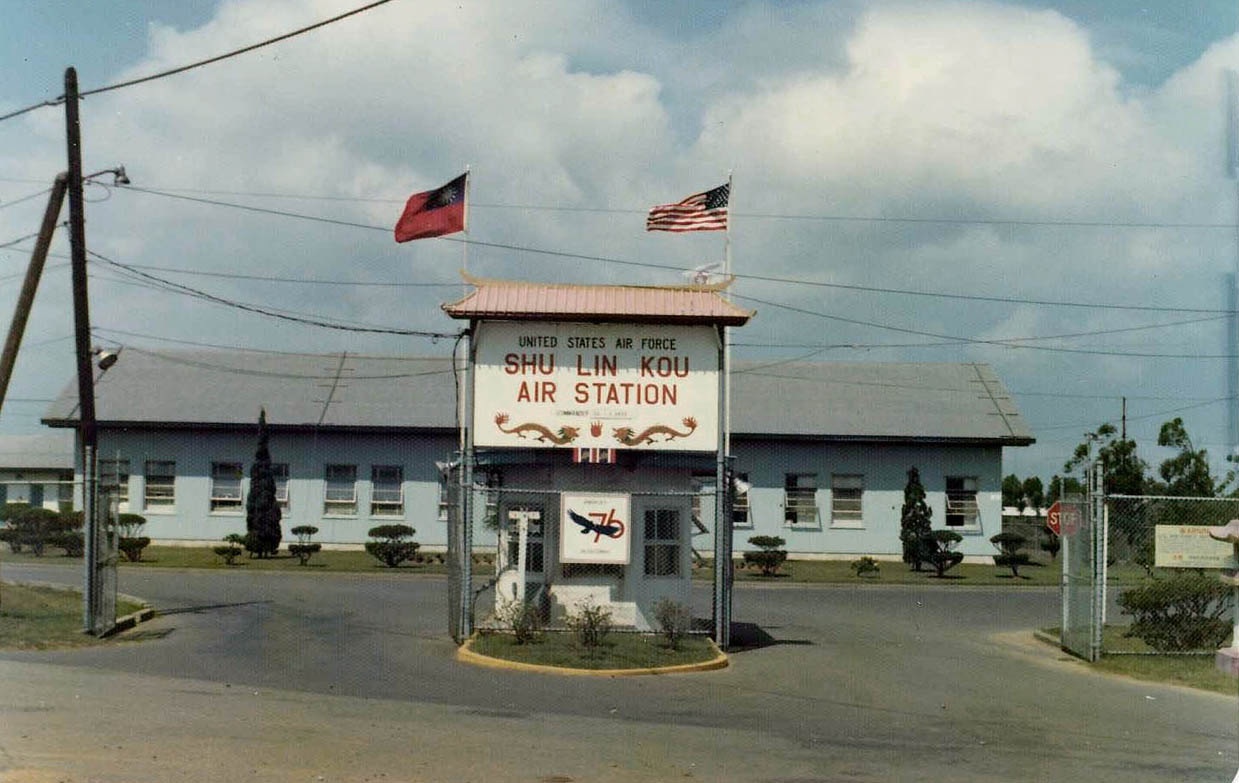
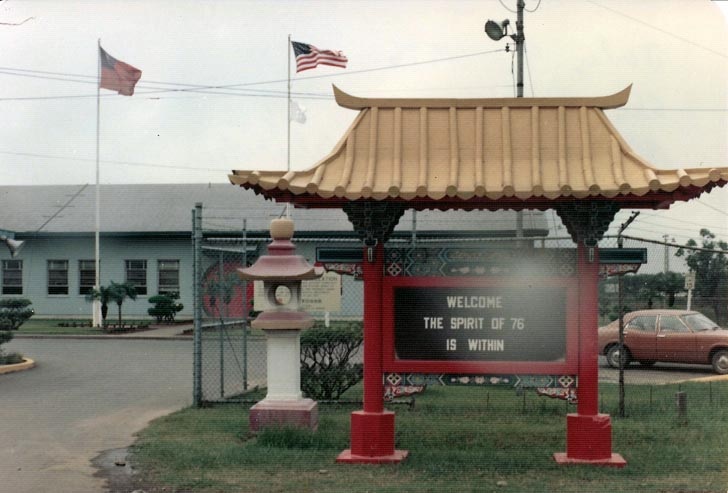
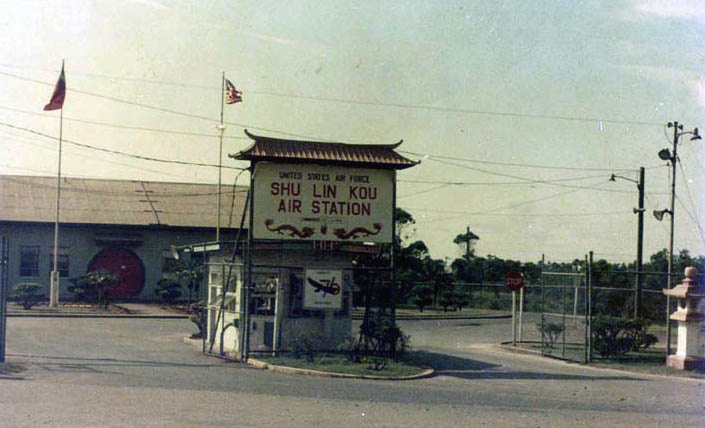
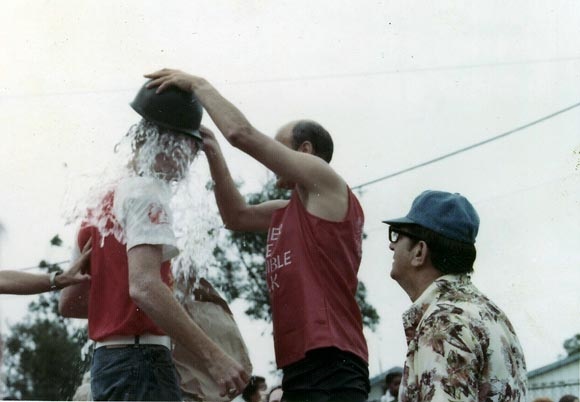
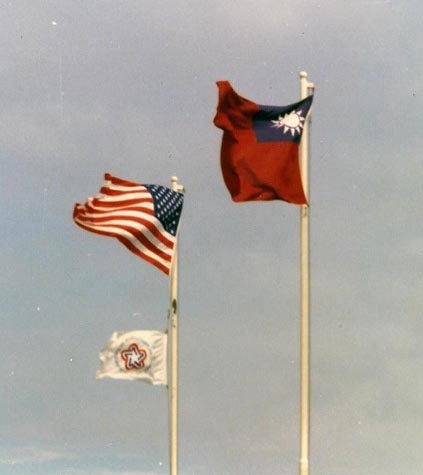
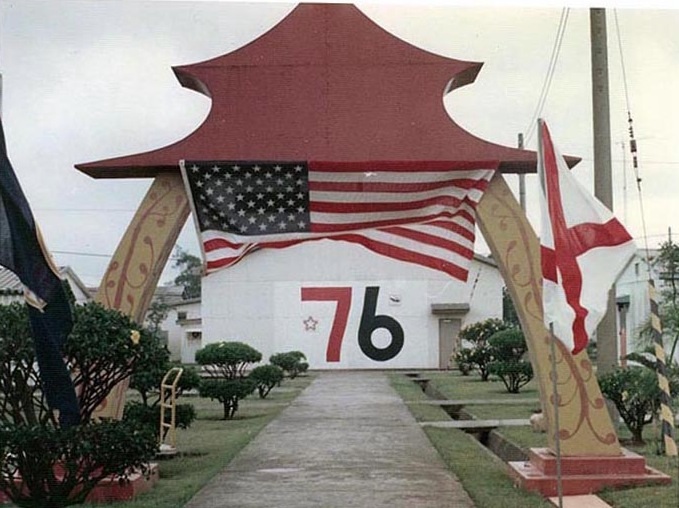 Photo credits: (Top Row) (1. & 3.) Roger & Catherine Jarvis (1975-77) (2.) Wen Hsiao (Shulinkou 1976)
Photo credits: (Top Row) (1. & 3.) Roger & Catherine Jarvis (1975-77) (2.) Wen Hsiao (Shulinkou 1976)
(Bottom Row) (1., 2., & 3.) Roger & Catherine Jarvis
(Click on Photos to Enlarge)
(Top Row) (1., 2., & 3.) July 4, 1976 shots of the Main Gate, Gate Sign, Headquarters building, and Bachelor Officers' Quarters (BOQ) on the far left (Photo 1.). Colonel James E. Kater was the Shulinkou base commander in 1976. The "76" and eagle placard below the "Shu Lin Kou Air Station" sign on the Guard Shack signified the 1976 Bicentennial celebration in the states commemorating the 200th year anniversary of the founding of the United States.
(Bottom Row) 1.) Lt. Colonel Jerome M. Wucher, Vice Group Commander (Operations Commander), pours a helmet full of water on Roger Jarvis' (MWR Recreation Services Chief) head at the Shulinkou Bicentennial celebration July 4, 1976. Ralph Mariani (MWR Chief), is on the bottom right. Bicentennial flag flies below the U.S. flag in front of Headquarters (also visible in all the photos in the top row above). 3.) Dragon Inn Dining Hall decorated for the Shulinkou Bicentennial celebration, July 4, 1976.
Note: "The base was notified in April 1976 that the American Revolution Bicentennial Administration had selected Shulinkou Air Station as an official bicentennial installation."
source: Feb. 27, 1977 Shulinkou Devil Dog newspaper, provided by Roger & Catherine Jarvis (1975-77)
Shulinkou 1975 to 1977
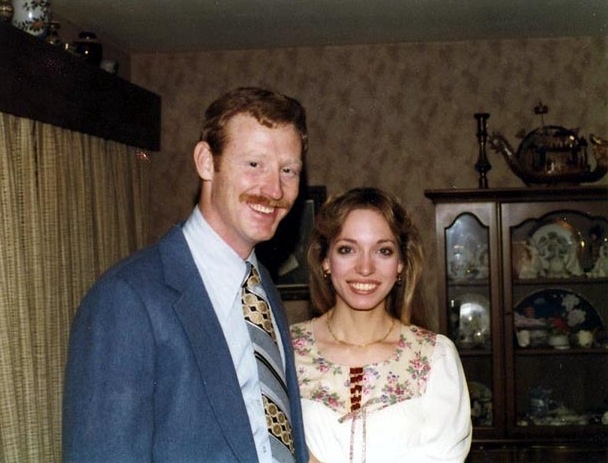
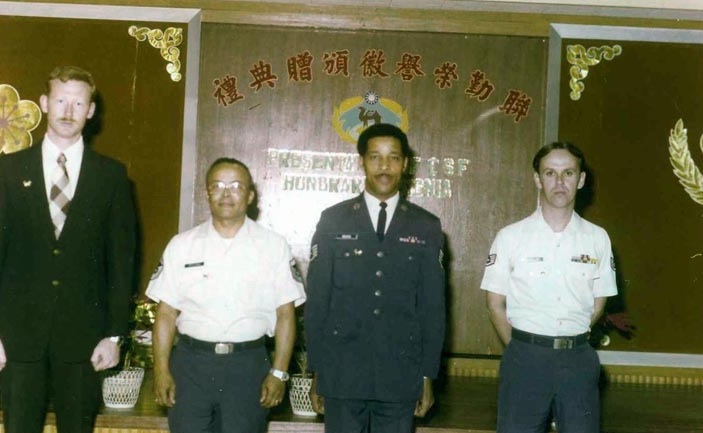
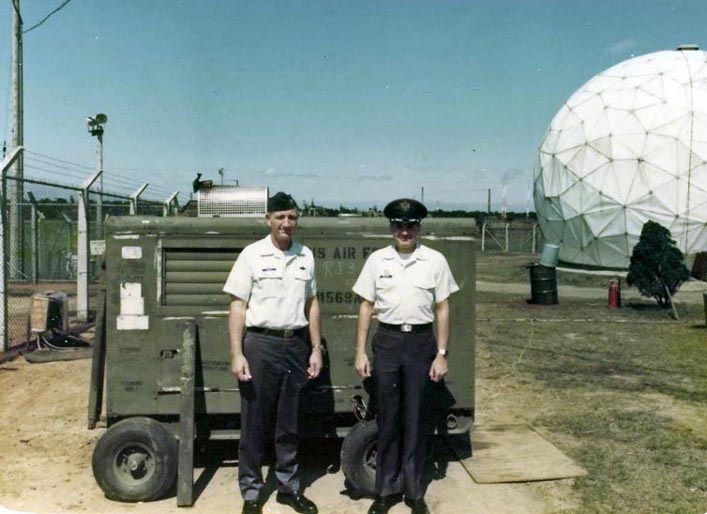
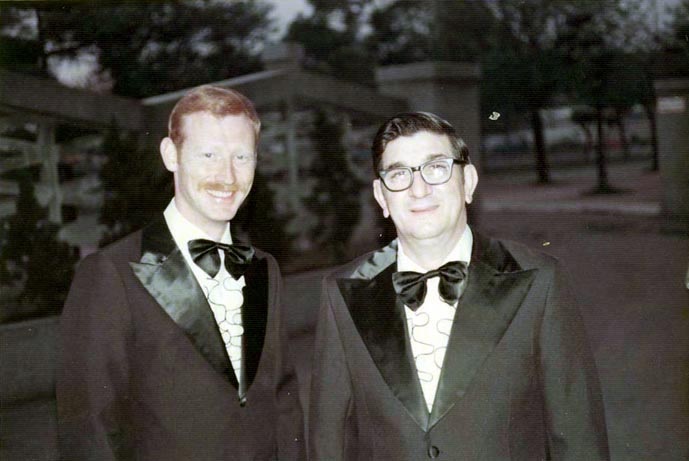 Photos by Roger & Catherine Jarvis (1975-77)
Photos by Roger & Catherine Jarvis (1975-77)
(Click on Photos to Enlarge)
(1.) 1977 shot of Roger and Catherine "Katie" Jarvis in Taipei. Catherine, a USAFSS SSgt. 202X0 Communications Analyst, arrived Jan 1976. Catherine's husband Roger, a USAF civilian employee (GS-11) and former Marine, arrived Sep 1975. He was the Linkou MWR Chief (Recreation Services). They both departed Mar 31, 1977. Shulinkou closed the next day.
(2.) 1976 shot of (from the left) Roger Jarvis (MWR Chief), CMSgt. Walder, "Unidentifed" SSgt., SSgt. Wayne Wheeler (far right).
(3.) Colonel James E. Kater (left), Shulinkou 6987th Group Commander (1974/75-March 1977), and Lt. Colonel Jerome M. Wucher, Vice Group Commander (Operations Commander).
(4.) Roger Jarvis and Ralph Mariani, MWR Directors, March 1976.
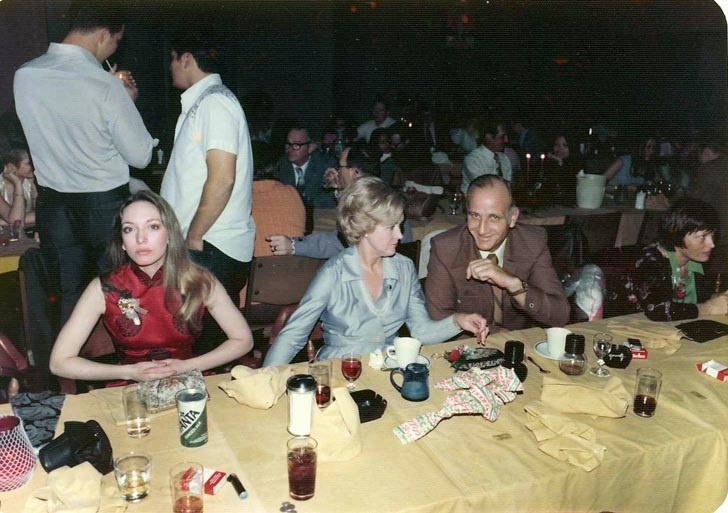
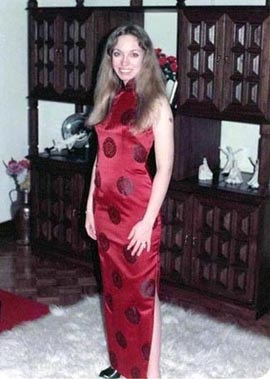
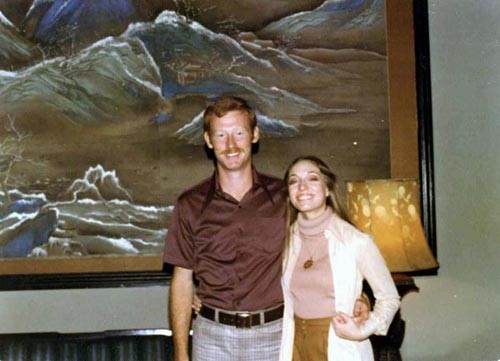
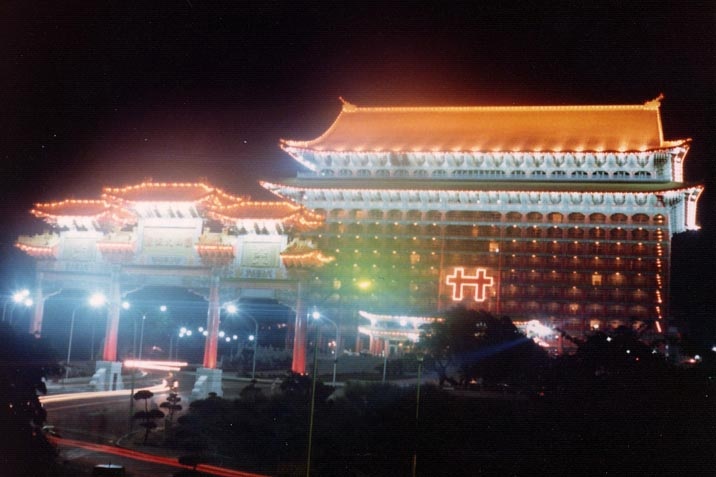
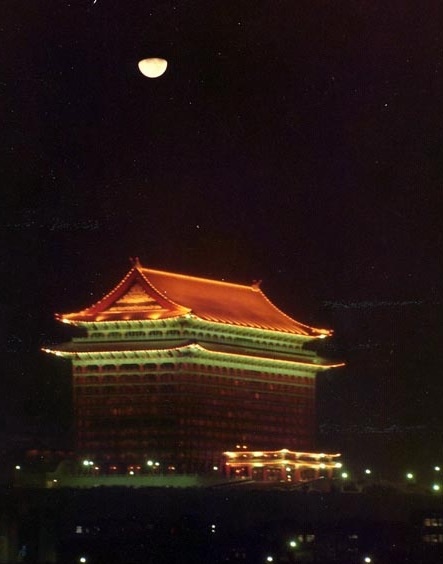 Photos by Roger & Catherine Jarvis (1975-77)
Photos by Roger & Catherine Jarvis (1975-77)
(Click on Photos to Enlarge)
(1.) 1976 Linkou Christmas party. Catherine Jarvis (left), and the 6987th Group Commander and his wife, Colonel and Mrs. James Kater.
(2.) Catherine Jarvis (1976-77) prior to the 1976 Linkou Air Force Ball.
(3.) Roger and Catherine Jarvis in the lobby of the Grand Hotel, 1976.
(4. & 5.) Oct 10, 1976 shots of the Grand Hotel lighted for Taipei's Double Ten Day (10-10-76) celebration that day.
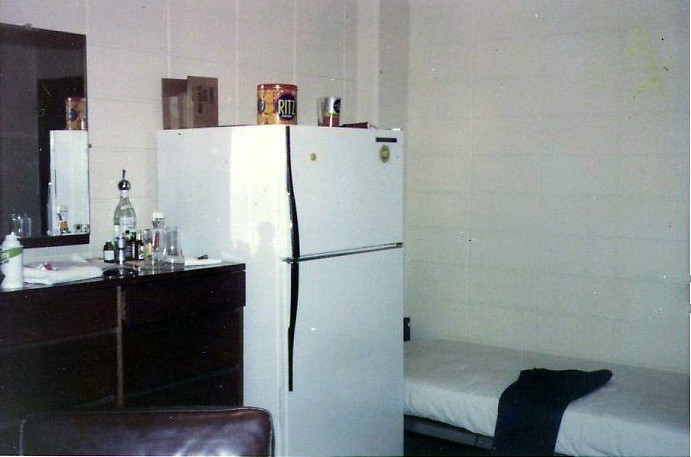
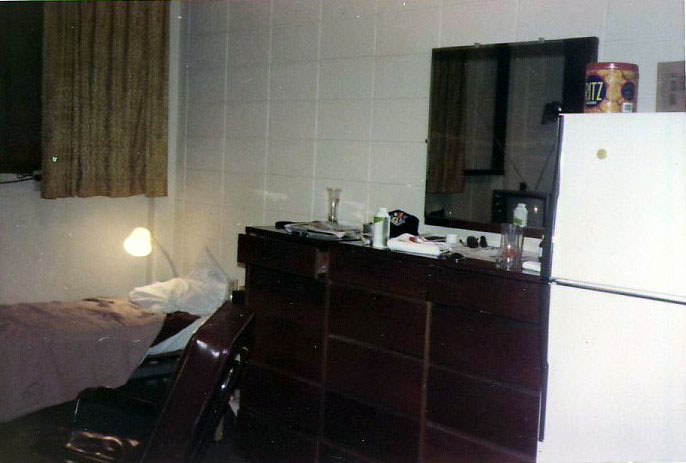
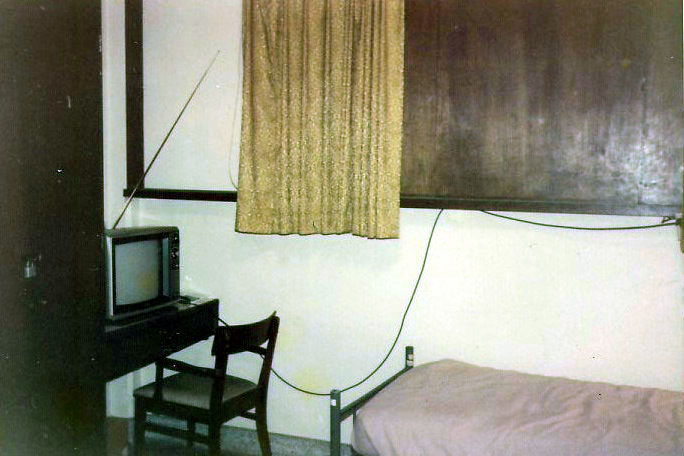 Photos by Robert Silva (1975-77)
Photos by Robert Silva (1975-77)
(Click on Photos to Enlarge)
(1., 2., & 3.) 1976/77 shots of a Shulinkou dormitory room in the "Day-Lady" barracks with a large refrigerator, TV, and two single bunks. (Refrigerators were not allowed in barracks rooms circa 1971, and all rooms were three-man with a single bunk and double bunk.)
Robert Silva (1975-77): "We mostly had single rooms as we were closing down in '77. We all had refrigerators. This room was on the second floor with the cops (Security Police) above us. The final month (March 1977) we were all moved downtown until we transferred the base to the host (ROC)." [07 Oct 2016]
The New North-South Highway

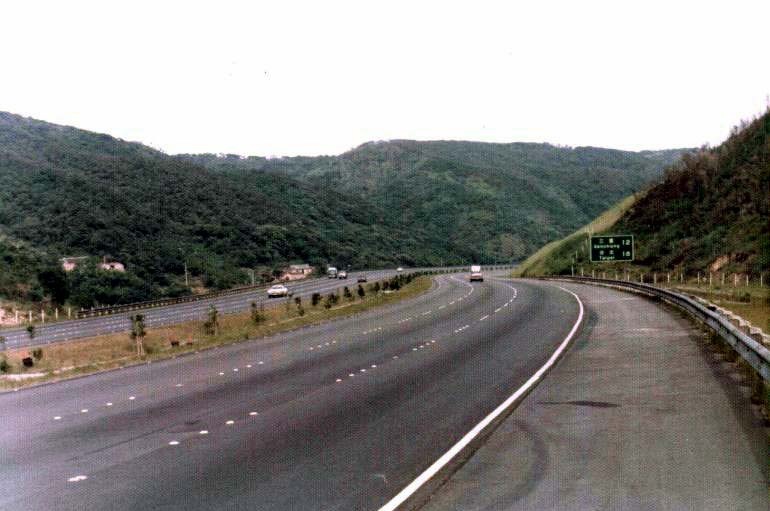
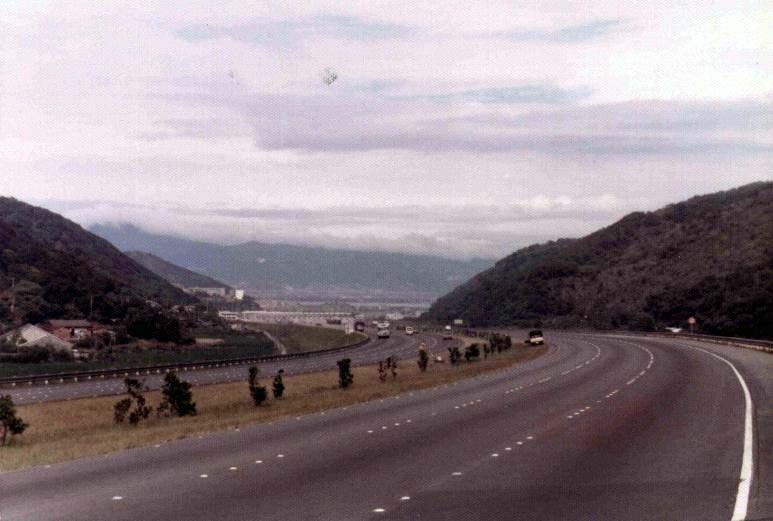
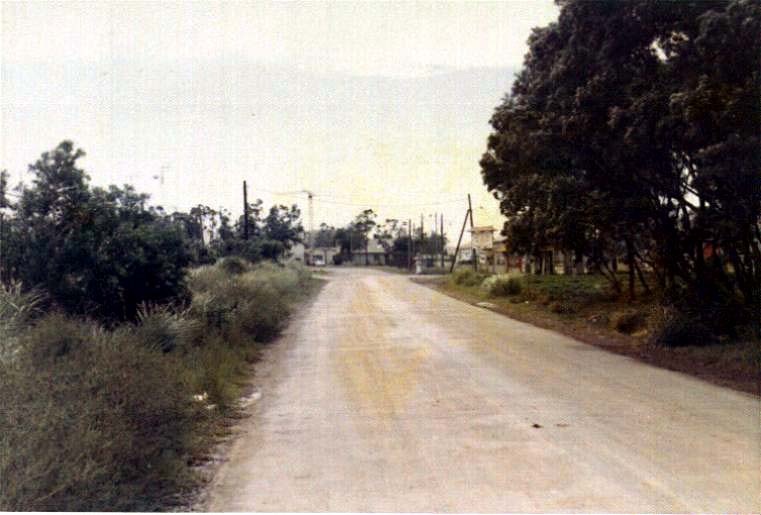
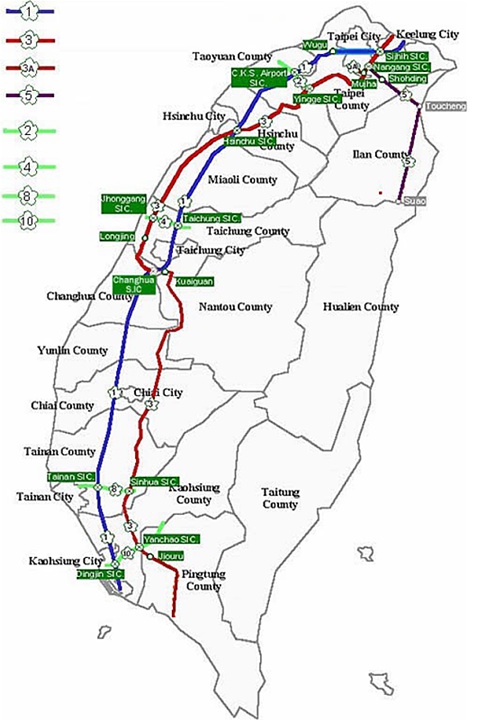 Photos: (1.) circa 1974 aerial photo (source unknown) (2., 3. & 4.) Al Budington (1976-77) (5.) Taiwan National Freeways and Expressways Map (2011), CECI, Taiwan
Photos: (1.) circa 1974 aerial photo (source unknown) (2., 3. & 4.) Al Budington (1976-77) (5.) Taiwan National Freeways and Expressways Map (2011), CECI, Taiwan
(Click on Photos to Enlarge)
1.) Circa 1974 aerial photo of Shulinkou Air Station showing the start of construction on the North-South Highway as labeled in the photo's background. "The construction began in 1970 on the north section of the North-South Highway from Keelung to Taipei was opened in fall 1974. The section from Taipei south to Jhongli City was completed in 1976, and the entire highway was opened in 1978.Ē The new highway skirted the base just to its south and was opened for use from Shlinkou to Taipei in fall 1974.
2.) Late 1976 or early 1977 shot of the new six-lane North-South Highway taken during a short 10 to 15 minute trip to Taipei from base...a major improvement from the long 45 minute trip previously on the old narrow and winding mountain road shown in photo (3.) on the right.
3.) Another late 1976 or early 1977 view along the newly opened highway with Taipei visible in the distance. The trip from Shulinkou to Taipei on the new multi-lane highway was only 10 to 15 minutes.
4.) A 1976 or early 1977 shot taken on the old mountain road with Shulinkou's Main Gate and buildings in the distance while returning on the 45 minute trip from Taipei.
5.) "Map of Taiwan's National Freeways and Expressways" (2011) shows the location of National Freeway No. 1, Taiwan's first freeway (blue line on map). Freeway No. 1 starts at Keelung at the northern tip of Taiwan, passes by Linkou and Taipei, and terminates at Kaohsiung at the southern end of the island. The northern section of Freeway No. 1 between Keelung, Taipei, and Shulinkou inkou was completed and opened in fall 1974.
Typhoon Billie August 12, 1976
"Typhoon Billie hit Taiwan August 12, 1976. Billie skirted the Ryūkyū Islands before making landfall in Taiwan and again in eastern China, producing huge waves that drowned 41 fishermen and swimmers along the coast of Japan. A JTWC weather station in Miyakojima reported a barometric pressure of 962 millibars and winds of 51 mph. In Ishigakijima, a weather station reported winds of 109 mph and a barometric pressure of 952 millibars.
Billie's second landfall was south of Taipei, where a weather station reported 81 mph winds. However, at the Taipei International Airport, the winds were at 40 mph with gusts up to 75 mph. Billie's impact in Taiwan was destructive as the storm sank three ships and damaged several others and killed seven people, leaving eight others missing, injured 24 and left $2.6 million (1976 USD) in damage." (source: "Wikipedia")
Typhoon Billie Hits Shulinkou August 12, 1976
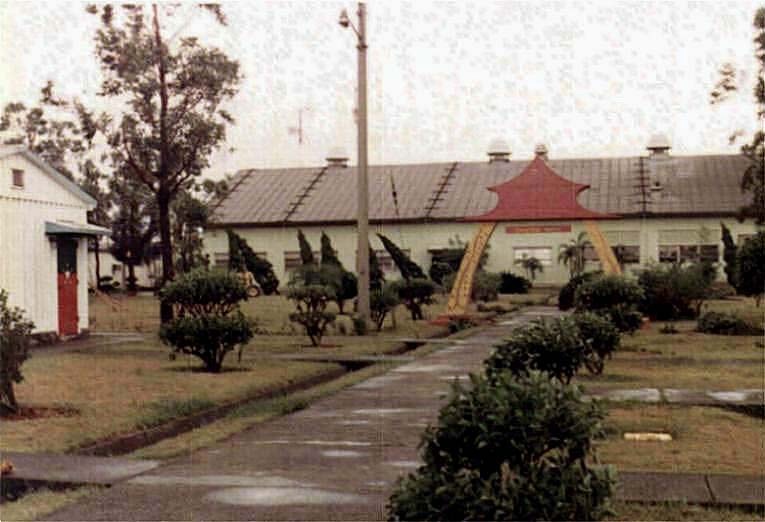
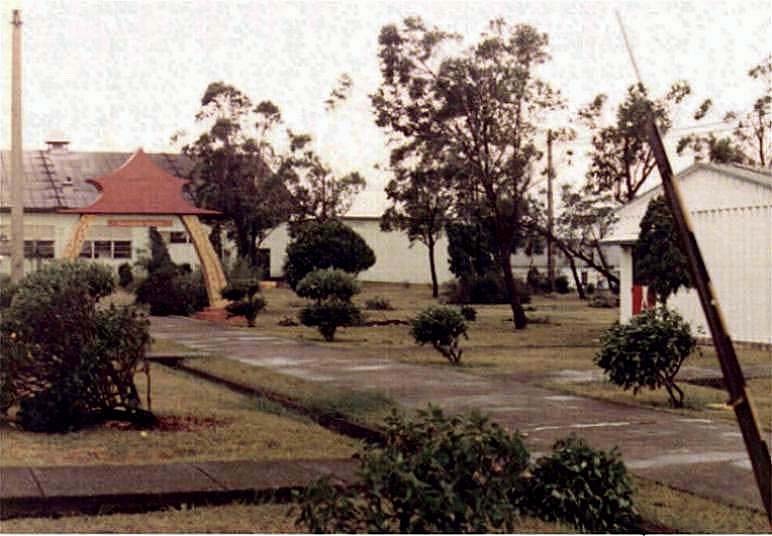
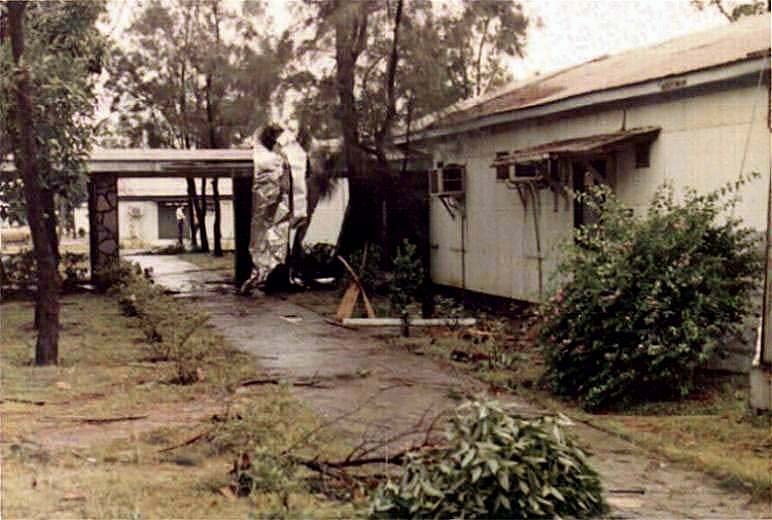 (Click on Photos to Enlarge) August 13, 1976 photos by Al Budington (1976-77)
(Click on Photos to Enlarge) August 13, 1976 photos by Al Budington (1976-77)
1.) August 13, 1976 shot taken standing at the rear of the Linkou Club showing "Typhoon Billie's" (Aug 12, 1976) damage to the Dragon Inn Dining Hall. The Dragon Inn was painted light green from its original white color and the ornate archway, trees, and shrubs were added sometime after 1974. The base Personnel Office (CBPO-ref map above-bldg. #26) is the small building on the far left. The Mail Room is visible in the left background to the left of the Chow Hall.
2.) Sequential shot taken August 13, 1976 from behind the Linkou Club showing "Typhoon Billie's" damage to the Dragon Inn and surrounding area. The base Education Office is the small white building on the far right. The Motor Pool buildings are visible in the right background.
3.) August 13, 1976 shot showing "Typhoon Billie's" damage to the building on the right that housed the base Cleaners, Tailors, Barber Shop and "Mini Snack Store" (located on opposite end of bldg.) and the BX to the far left (not visible-entrance far left under the canopy). Shot was taken from the vicinity of the Navy barracks looking toward the center of base. The building in the background behind the airman is the base Bank.
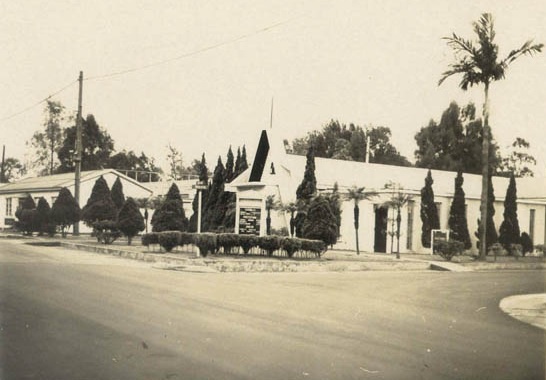
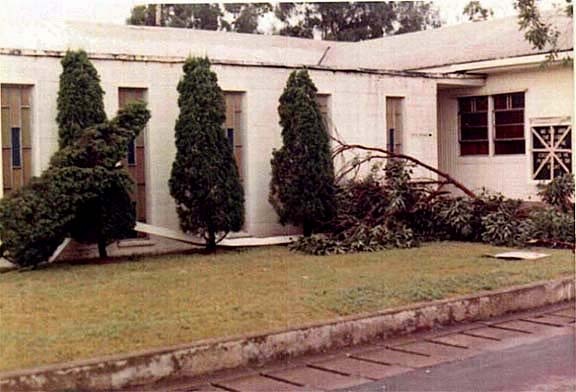
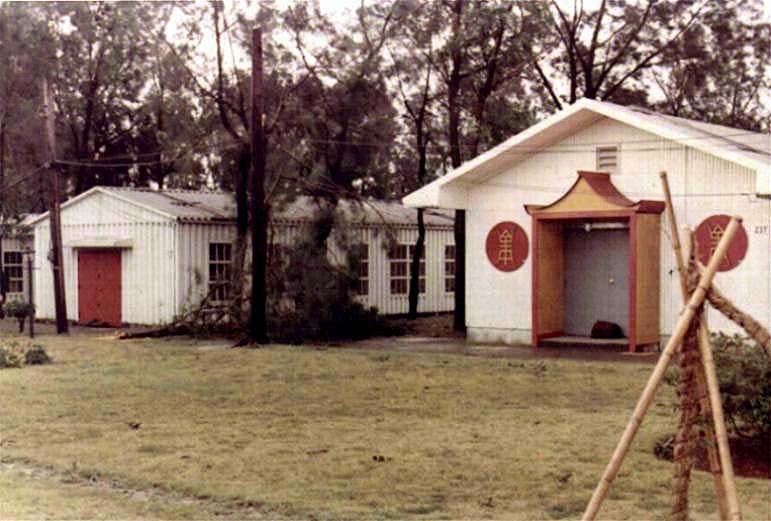
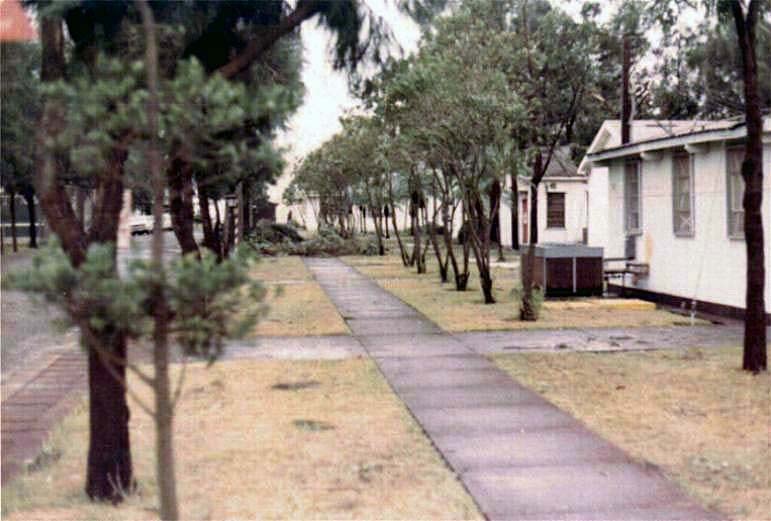 (Click on Photos to Enlarge) Photo credits: (1.) Wen Hsiao (2., 3., & 4.) Al Budington
(Click on Photos to Enlarge) Photo credits: (1.) Wen Hsiao (2., 3., & 4.) Al Budington
1.) 1976 shot of the base Chapel taken from the street in front of the Dispensary, which is just off to the right of the photo. The sign outside the Chapel lists the times for Catholic, Protestant, and Jewish services. The base Library is on the far left. The street sign on the corner reads "Oriental" street (to the right).
2.) August 13, 1976 photo of the base Chapel showing the damage caused by Typhoon Billie.
3.) August 13, 1976 shot showing Typhoon Billie's damage to the small buildings located behind the BX/Cleaners and Barracks near the Swimming Pool (to the left of the third building on the far left). The ornate entrance and signs with Chinese characters were added to the building on the far right (located right behind the base Cleaners and BX) after 1974...in 1970/71 this building served as the base Recreation Center and had a couple of pool tables and Ping Pong tables.
4.) August 13, 1976 shot of the backside of the buildings (far right) in the previous photo showing more damage to the base from Typhoon Billie. This shot was taken standing in the vicinity of the base Water Tower (located in the front corner of base-opposite Main Gate) looking back toward the Dawg Flight barracks ( not visible-in distance straight back at the end of the sidewalk). The base Tennis Courts are visible in the far left background next to the parked cars.
U.S. Navy C-118 Crash at Taipei's Sungshan Airport, 15 Feb 1977
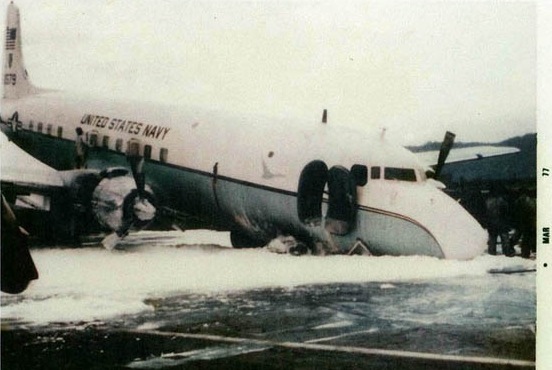
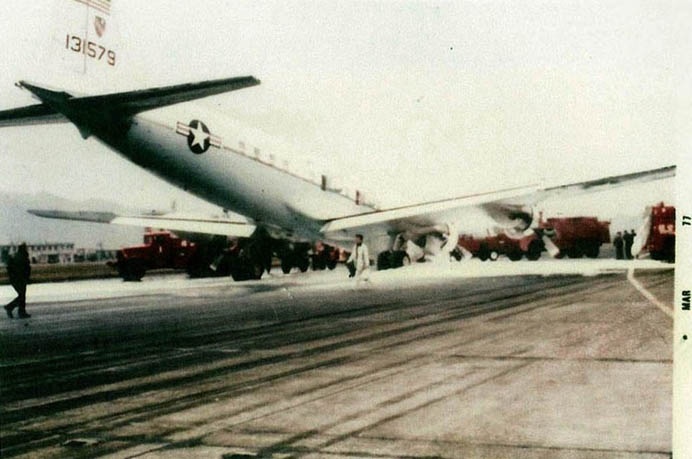
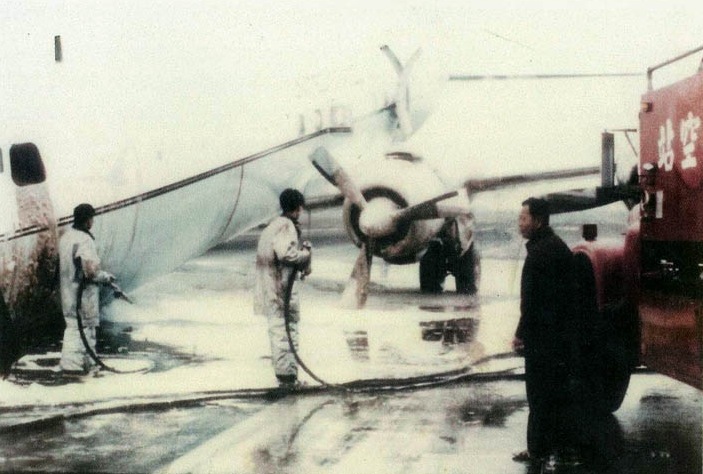
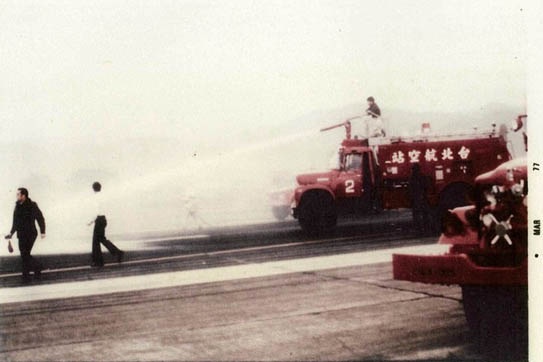 Photos above and below by Roger Jarvis (1975-77)
Photos above and below by Roger Jarvis (1975-77)
(Click on Photos to Enlarge)
February 1977 shots of the crashed C-118 at the Sungshan Air Base in Taipei. In the first photo a long gash in the
plane's fuselage is visible between the the engine and doorway, where the tip of an inboard propeller cut through it.
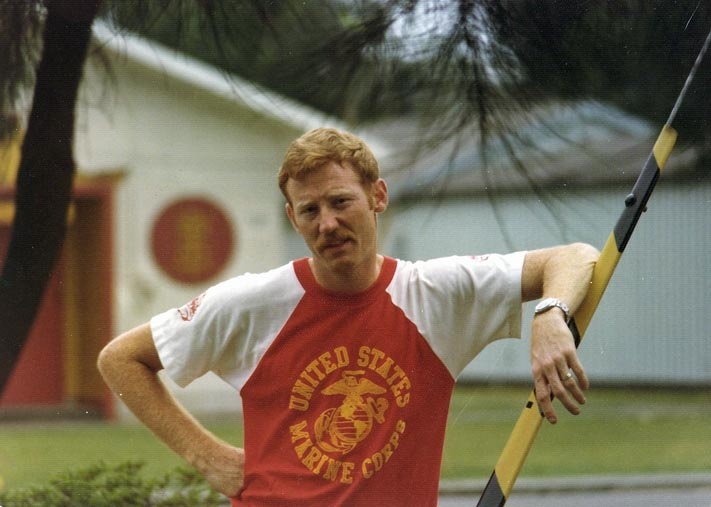
(Photo on Right- Click to Enlarge) 1975 shot of Roger Jarvis ('75-'77), MWR Recreation Services Chief, outside the Linkou BX (off to the right).
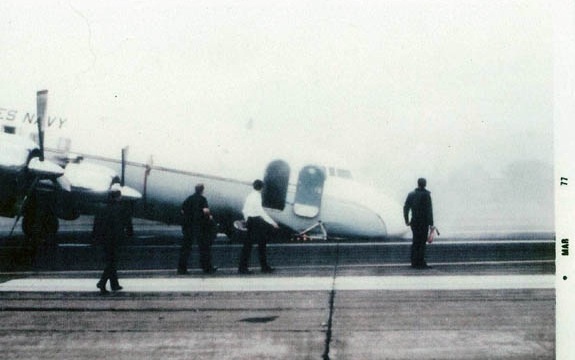 Roger Jarvis (Shulinkou: Sept 1975 to March 31, 1977): "I was flying to Clark AB, Philippines 15 Feb 1977 on Admiral Snyder's C-118 [the 'Blue Goose], sitting in a window seat over the right wing. Adm. Snyder was Vice Admiral and Commander of USTDC (U.S. Taiwan Defense Command) and subordinate units on Taiwan. We began a routine takeoff down the runway at the military airport (Sungshan Air Base/Airport) in Taipei, and as we reached takeoff speed there was a wild vibration, then a loud 'boom' as the aircraft's nose slammed down onto the runway. The front wheel strut collapsed and the plane went careening down the runway at about 120 mph. The tip of the right inboard propeller sheared off and sliced through the right side of the fuselage about five rows ahead of me, and struck a crew member, a Navy NCO. By the time the aircraft came to a halt the interior of the plane was filled with smoke (photo on left) and I could see flames coming from the cockpit.
Roger Jarvis (Shulinkou: Sept 1975 to March 31, 1977): "I was flying to Clark AB, Philippines 15 Feb 1977 on Admiral Snyder's C-118 [the 'Blue Goose], sitting in a window seat over the right wing. Adm. Snyder was Vice Admiral and Commander of USTDC (U.S. Taiwan Defense Command) and subordinate units on Taiwan. We began a routine takeoff down the runway at the military airport (Sungshan Air Base/Airport) in Taipei, and as we reached takeoff speed there was a wild vibration, then a loud 'boom' as the aircraft's nose slammed down onto the runway. The front wheel strut collapsed and the plane went careening down the runway at about 120 mph. The tip of the right inboard propeller sheared off and sliced through the right side of the fuselage about five rows ahead of me, and struck a crew member, a Navy NCO. By the time the aircraft came to a halt the interior of the plane was filled with smoke (photo on left) and I could see flames coming from the cockpit.
There was no information given from the cockpit and there was no panic. The fire in the front of plane was now clearly visible, and I knew we were probably seconds away from being engulfed in a giant fireball. I yelled for everyone to head for the two window exits to escape the burning aircraft. I was in three helicopter crashes while in the Marines, and I all wanted to do was get off that plane.
An Air Force chaplain panicked and froze in front of me at the window exit, so I had to nudge him out the exit onto the wing ...using my size 12 boot. He broke his right ankle from the fall from the wing to the tarmac about seven or eight feet below. I then pulled him from the area. The other injuries amounted to a serious cut on the Navy NCO hit by the propeller blade, and some minor burns, abrasions, and bruises. I'm sure everyone's underwear needed a thorough washing afterward.
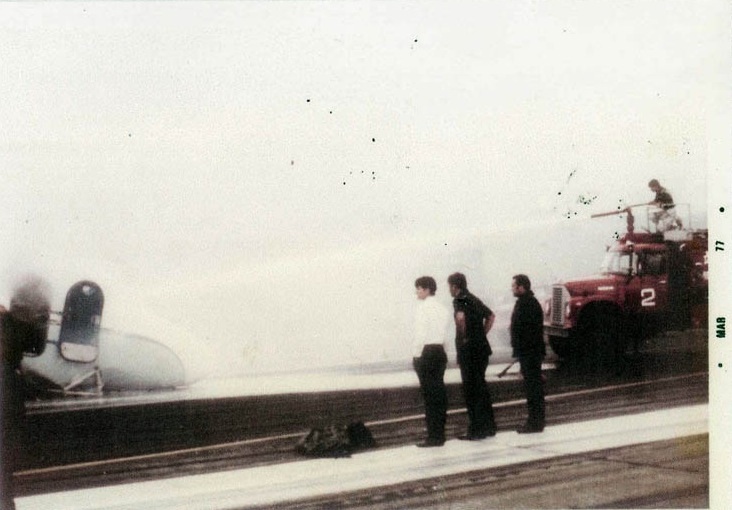 If all this excitement wasn't enough, the laugh of the century occurred. Two of the Chinese fire trucks, speeding toward the crash site in opposite directions ... you guessed it... collided about 50 yards from the plane. We all had the opportunity to actually witness a real Chinese fire drill...!
If all this excitement wasn't enough, the laugh of the century occurred. Two of the Chinese fire trucks, speeding toward the crash site in opposite directions ... you guessed it... collided about 50 yards from the plane. We all had the opportunity to actually witness a real Chinese fire drill...!
Needless to say, we did not get to Clark that day. I took photos (above) with my Pentax after the Chinese firemen arrived at the crash site. Of course, there was the usual military investigation, which proved the pilot, Navy Lieutenant Commander Doug Wickman, made the right decision not to takeoff, which minimized injuries. I never sat in a window or middle seat on any aircraft again.
Postscript: Flash forward to 2007...30 years after the accident. I met a man in downtown Portland, Oregon while we waited in line to attend a Boy Scout recognition breakfast. He noticed my patch from the Far East Council on the Scout jacket I was wearing. Turns out he was with the U.S. Army intel on Taiwan in 1977 and was on the same plane with me that crashed. We were also in the same Scout district the entire time we were on Taiwan...and our paths never crossed until 30 years later. We remain good friends. [Feb. 2014]
U.S. Navy C-118 Crash (Continued)
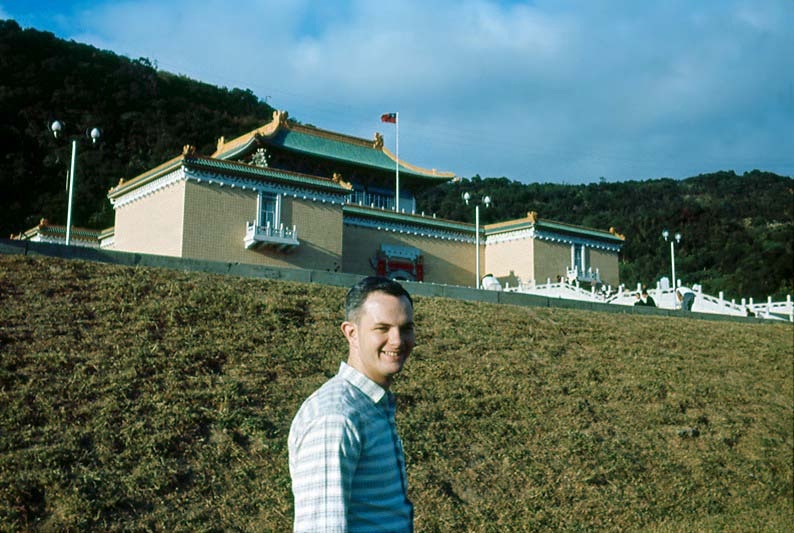
(Photo on Right) Les Duffin at Taiwan's National Palace Museum in 1966. Photo credits: right photo by Les Duffin, left photo and below right by Roger Jarvis
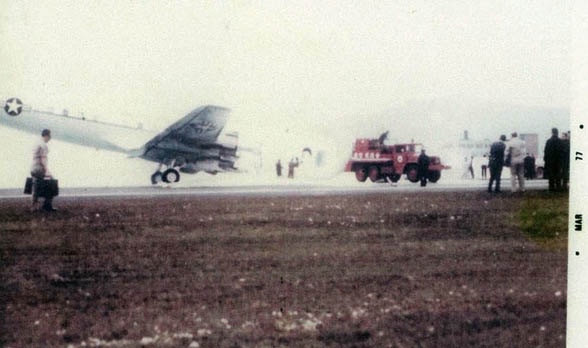 Les Duffin (Shulinkou 1962-66, Tainan AB 1971-73, and TDC Taipei 1976-78) recalls the C-118 crash: "Roger Jarvis' experience (story above) aboard the C-118 that crashed February 15, 1977, brought back many memories. The USTDC (U.S. Taiwan Defense Command) C-118 command aircraft, nicknamed the 'Blue Goose', was of more than passing interest to me. I had flown on it a number of times in the preceding two years. By the time this accident occurred, I was assigned to the OSI unit in Taipei and was in my fourth Taiwan tour. Our offices were in the TDC headquarters building, having moved there when Taipei Air Station closed in 1976.
Les Duffin (Shulinkou 1962-66, Tainan AB 1971-73, and TDC Taipei 1976-78) recalls the C-118 crash: "Roger Jarvis' experience (story above) aboard the C-118 that crashed February 15, 1977, brought back many memories. The USTDC (U.S. Taiwan Defense Command) C-118 command aircraft, nicknamed the 'Blue Goose', was of more than passing interest to me. I had flown on it a number of times in the preceding two years. By the time this accident occurred, I was assigned to the OSI unit in Taipei and was in my fourth Taiwan tour. Our offices were in the TDC headquarters building, having moved there when Taipei Air Station closed in 1976.
I just happened to be at Sungshan later on the day of the crash. I was sitting in the airport restaurant, having lunch with an airport official. We looked out the window and there was the 'Goose' (C-118) being towed by, in the direction of the military hangars, with its nose resting on some sort of cart and at least some of the propeller tips missing.
Of course when I returned to the office I wanted to find out what had happened, and the guys in the TDC office that managed the flights told this story: The C-118's nose gear had a metal pin that was normally removed while the aircraft was on the ground. That freed up the gear so a tow bar could be attached and the plane could be pulled around by a tug. But on that day some young Navy crewman who had towed the Goose into position for its flight forgot to re-insert the pin. Apparently the nose gear still responded to the controls, even without the pin, while taxiing out for takeoff. But when the takeoff run began and the plane gained speed, the nose wheel began to pinwheel. Eventually the stress was too much and the strut snapped off, dumping the nose onto the tarmac and shearing off some of the props' tips when they hit the ground.
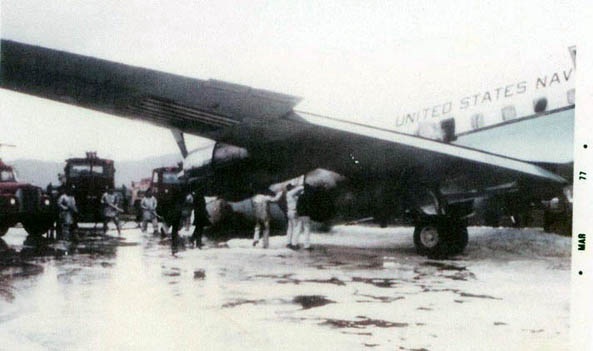 The TDC command pilot at that time, Navy Lieutenant Commander Doug Wickman, was at the controls. One of the severed tips from the number two engine also sliced through the cockpit, flying past him, just a few inches behind his head. Wickman was something of a character and used to joke, after difficult crosswind landings in Hong Kong that he had "cheated death again." That morning he had actually done just that.
The TDC command pilot at that time, Navy Lieutenant Commander Doug Wickman, was at the controls. One of the severed tips from the number two engine also sliced through the cockpit, flying past him, just a few inches behind his head. Wickman was something of a character and used to joke, after difficult crosswind landings in Hong Kong that he had "cheated death again." That morning he had actually done just that.
The decision was eventually made that it would be too expensive to repair the Goose, and a search began to see if the Navy might have another plane it could spare. TDC was finally given a surplus Navy C-47 Gooney Bird, but it was hardly the same. The Gooney Bird was much smaller and slower, and not nearly as comfortable: half the cabin was taken up by cargo space. I flew it just once to Hong Kong in early 1978 and recall the entire left side of the cabin was occupied by liquor destined from the Embassy Shop in Taipei to the consulate in Hong Kong. It was a routine supply run, the consulate didnít have an embassy shop of its own and the embassy shop in Taipei was responsible for supporting it.
The announcement that all US military would leave Taiwan didnít occur until December 1978, and I think the last troop actually departed around March of 1979. There really werenít many left at the end. Linkou, as you know, closed in 1977, and CCK, Tainan, and Taipei Air Station were gone by then too. So Iíd guess there were just a few hundred GIs left when the axe finally fell." [21 Feb 2014]
The Shulinkou "Devil Dog" Newspaper 23 February 1977 Final Edition, Special Commemorative Issue.
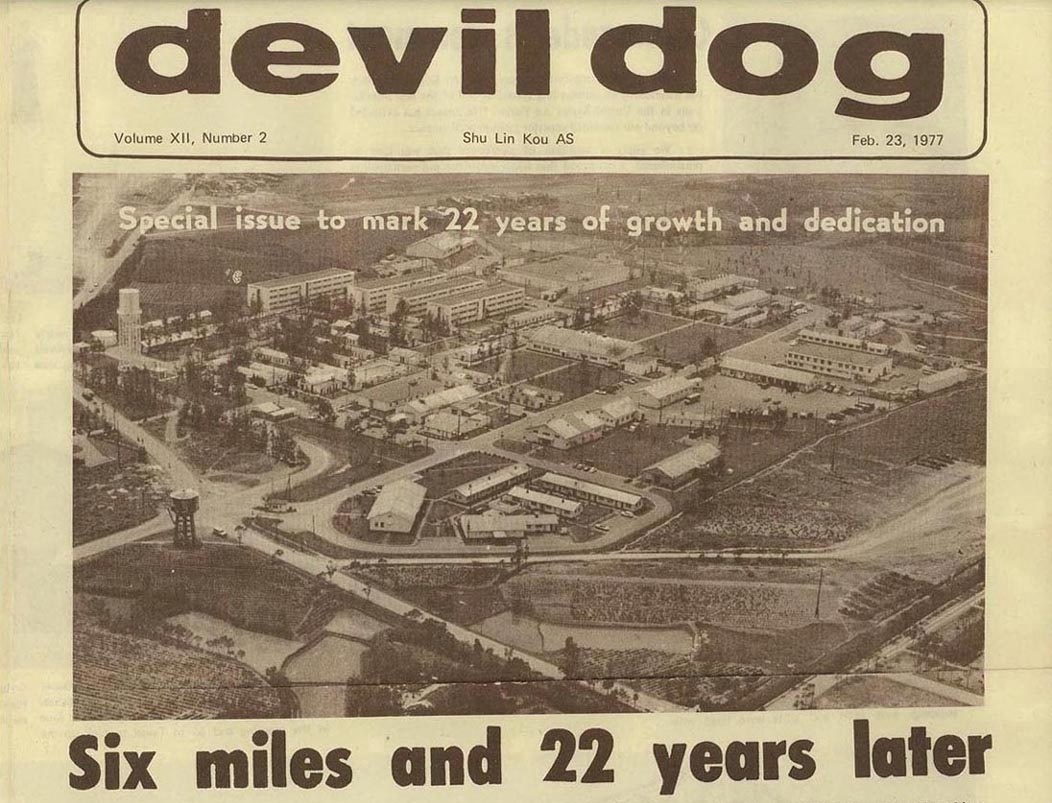
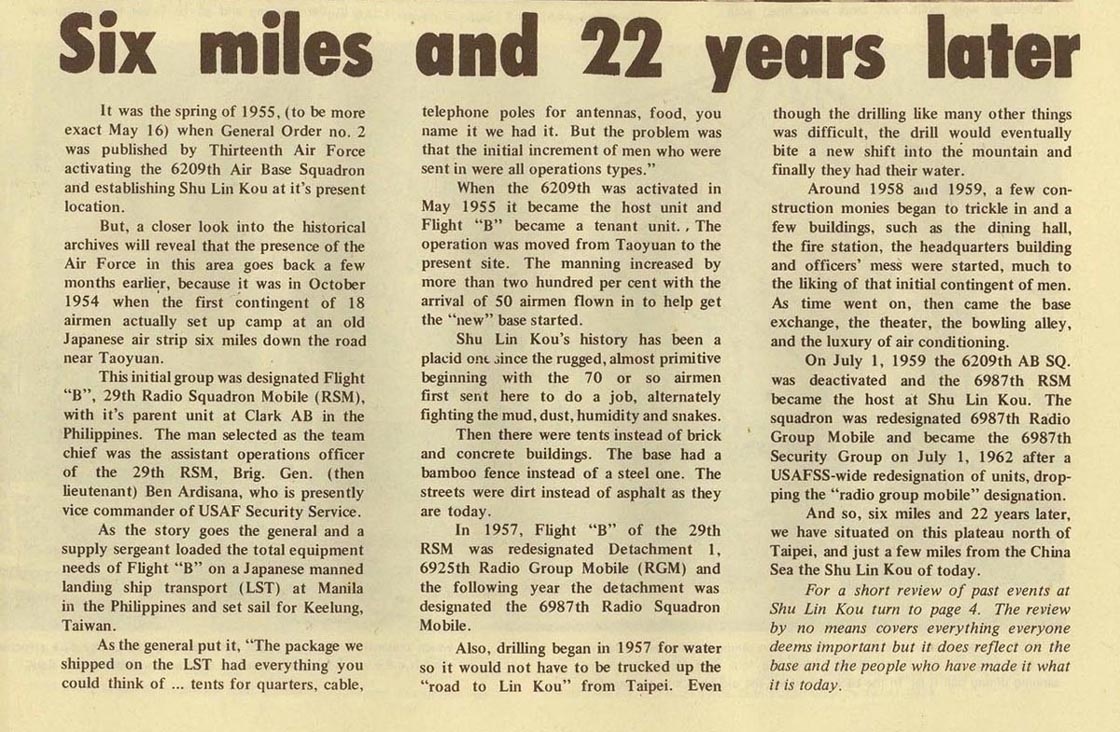
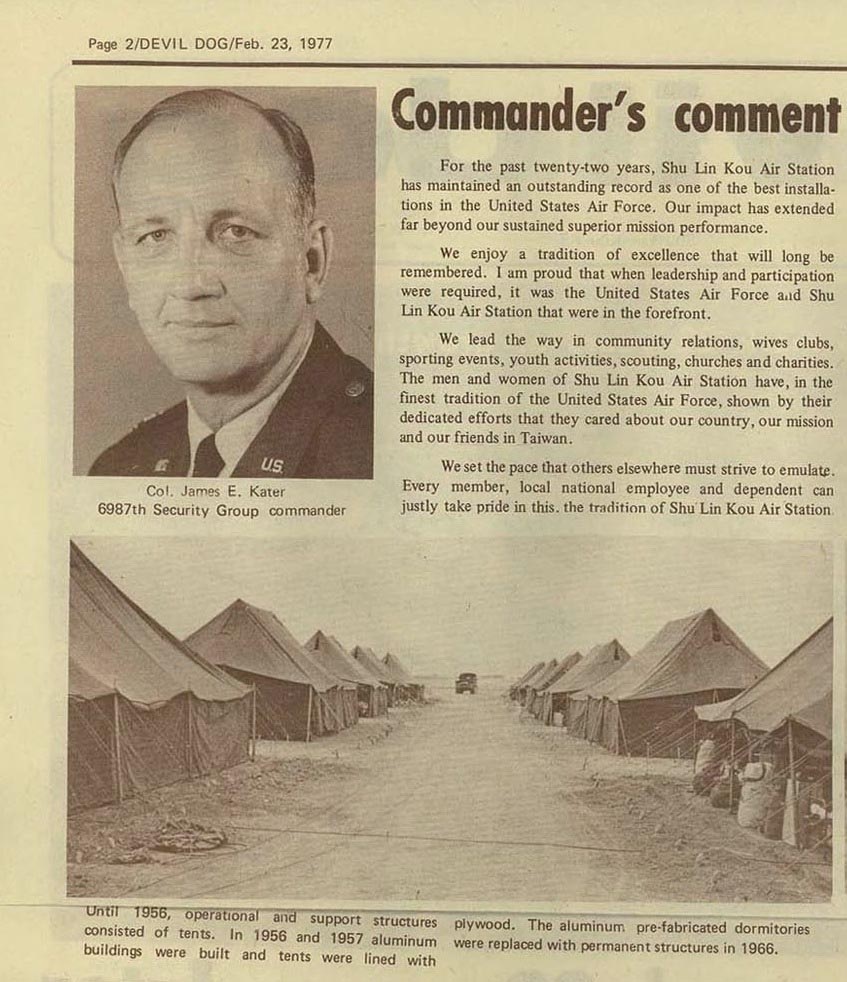
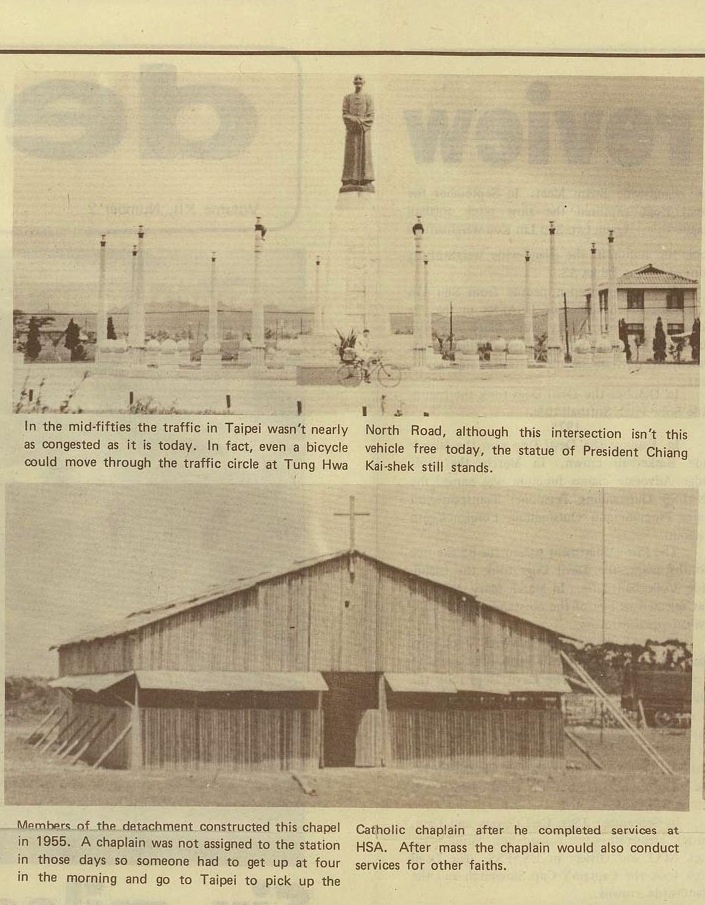
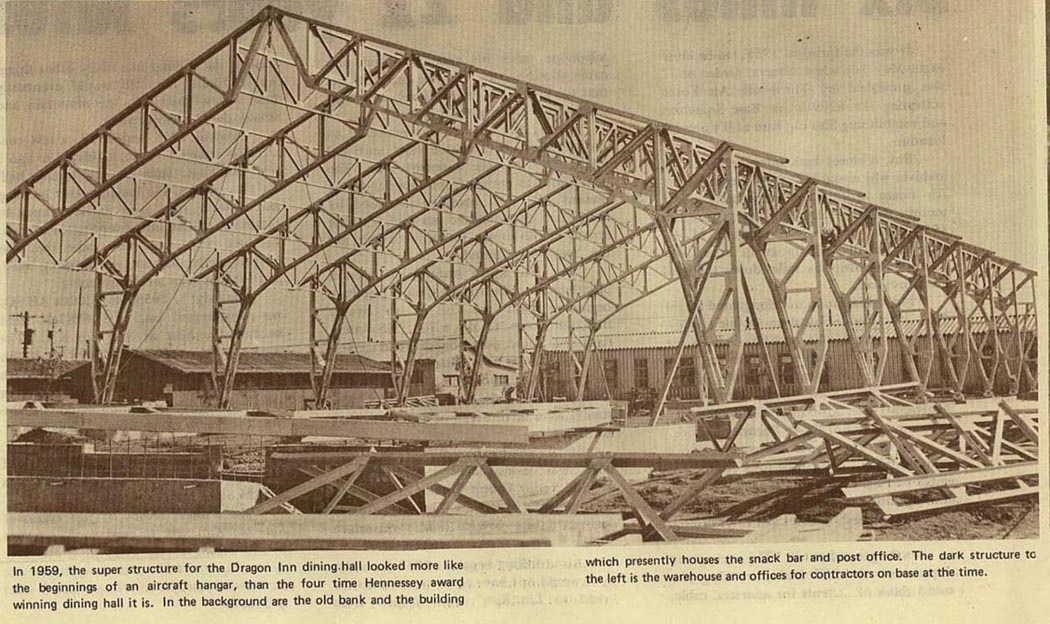
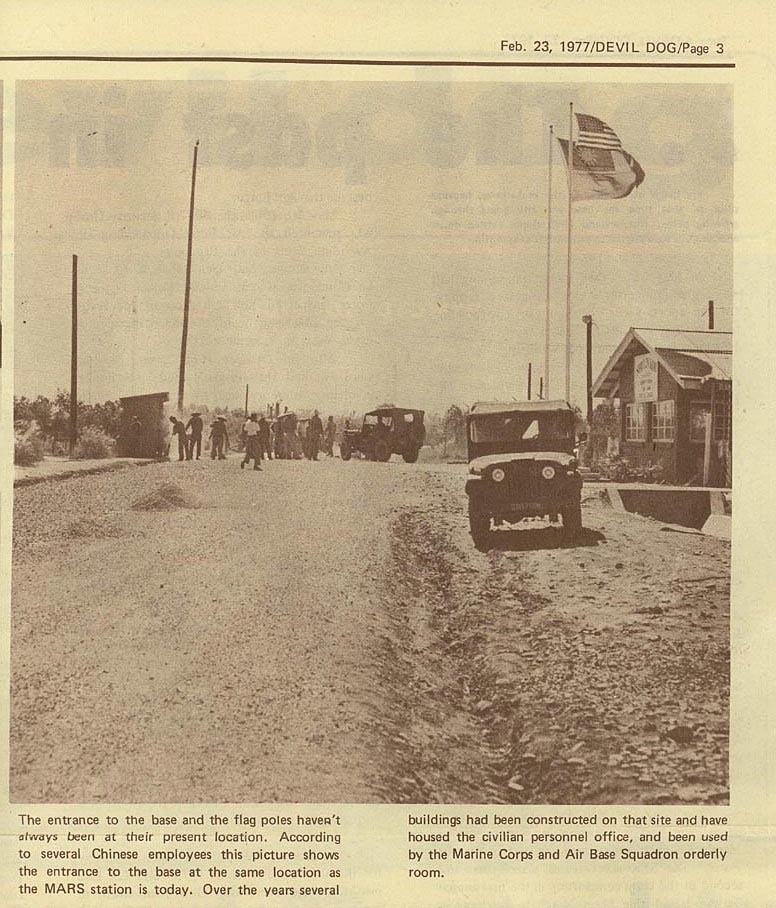
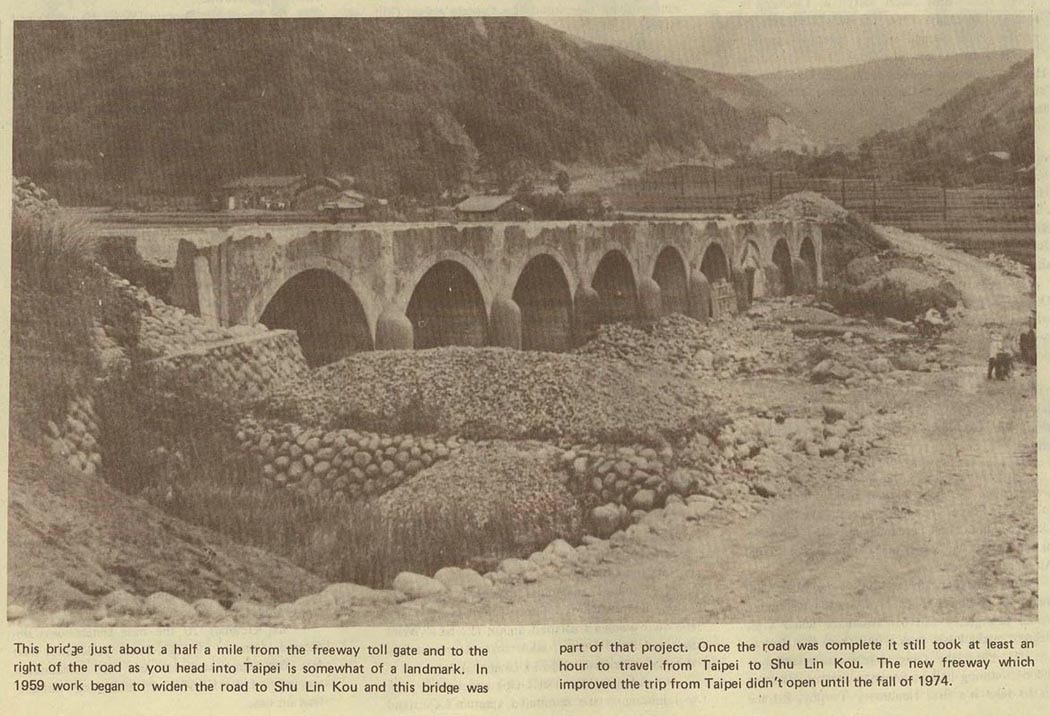
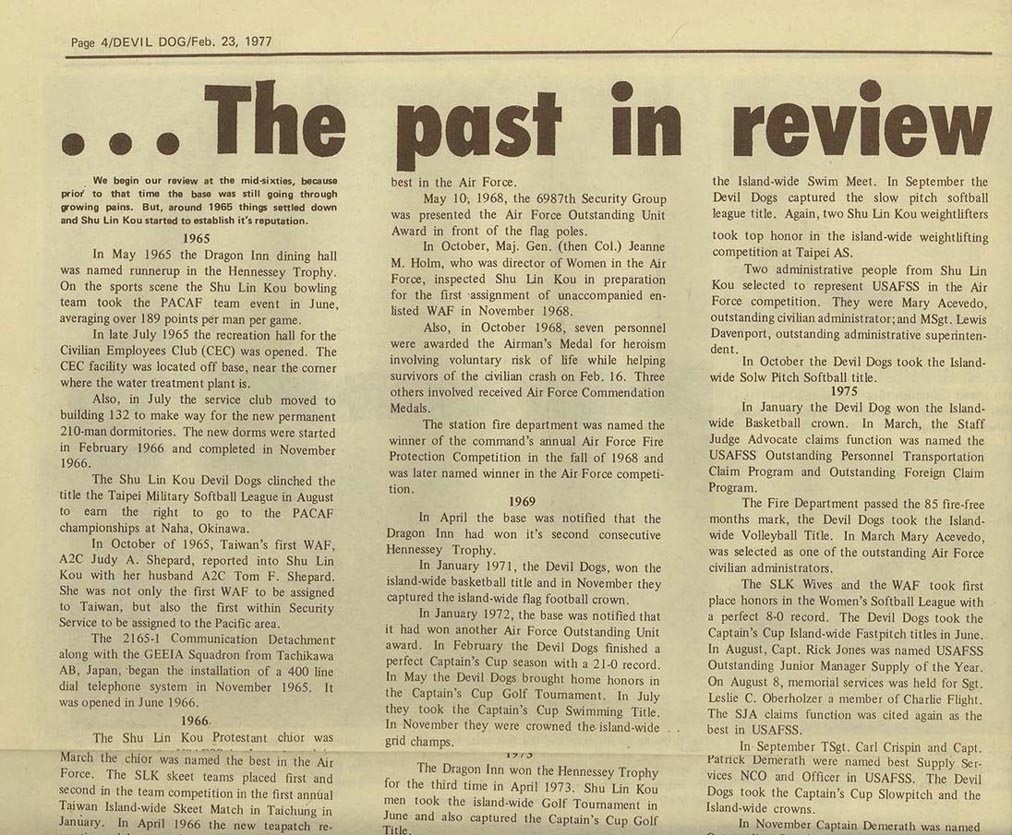
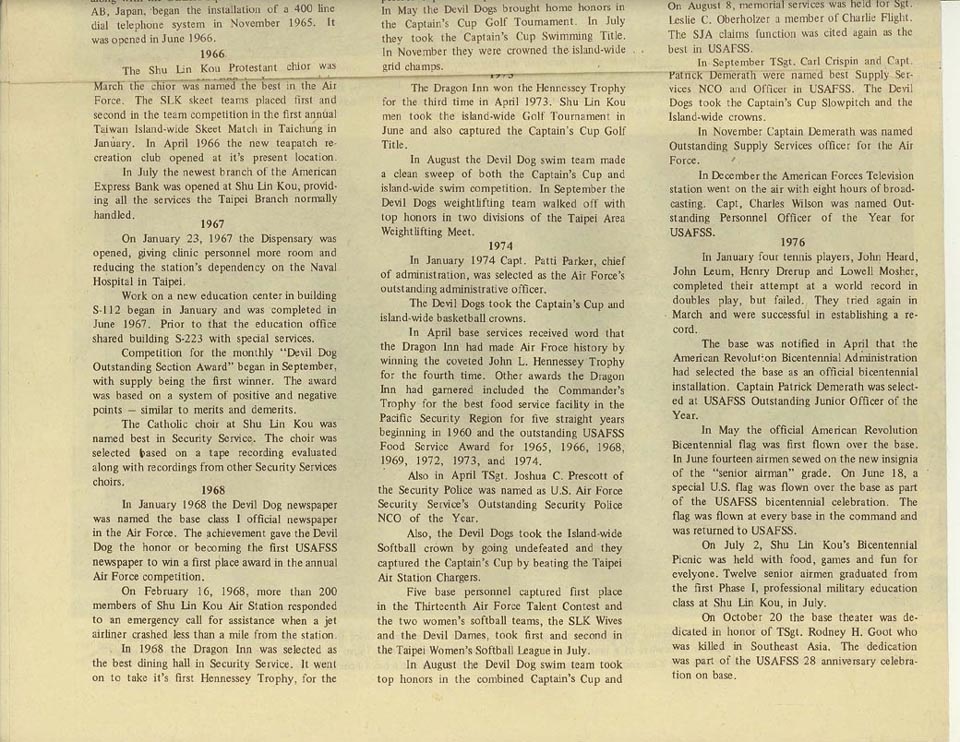 source: the Shulinkou Devil Dog base newspaper, Feb 23, 1977 edit., provided by Roger Jarvis (1975-77)
(Click on Images to Enlarge - to Zoom-in click again when open)
source: the Shulinkou Devil Dog base newspaper, Feb 23, 1977 edit., provided by Roger Jarvis (1975-77)
(Click on Images to Enlarge - to Zoom-in click again when open)
The complete February 23, 1977 edition of the Shulinkou Devil Dog base newspaper. This was a special commemorative edition, covering the past 22
years of Shulinkou's history, prior to the base closing five weeks later. All four pages of the Feb 23, 1977 edition are shown above in its entirety.
"Lessons Learned, 31 March 1977", James E. Kater, 6987th Group Commander
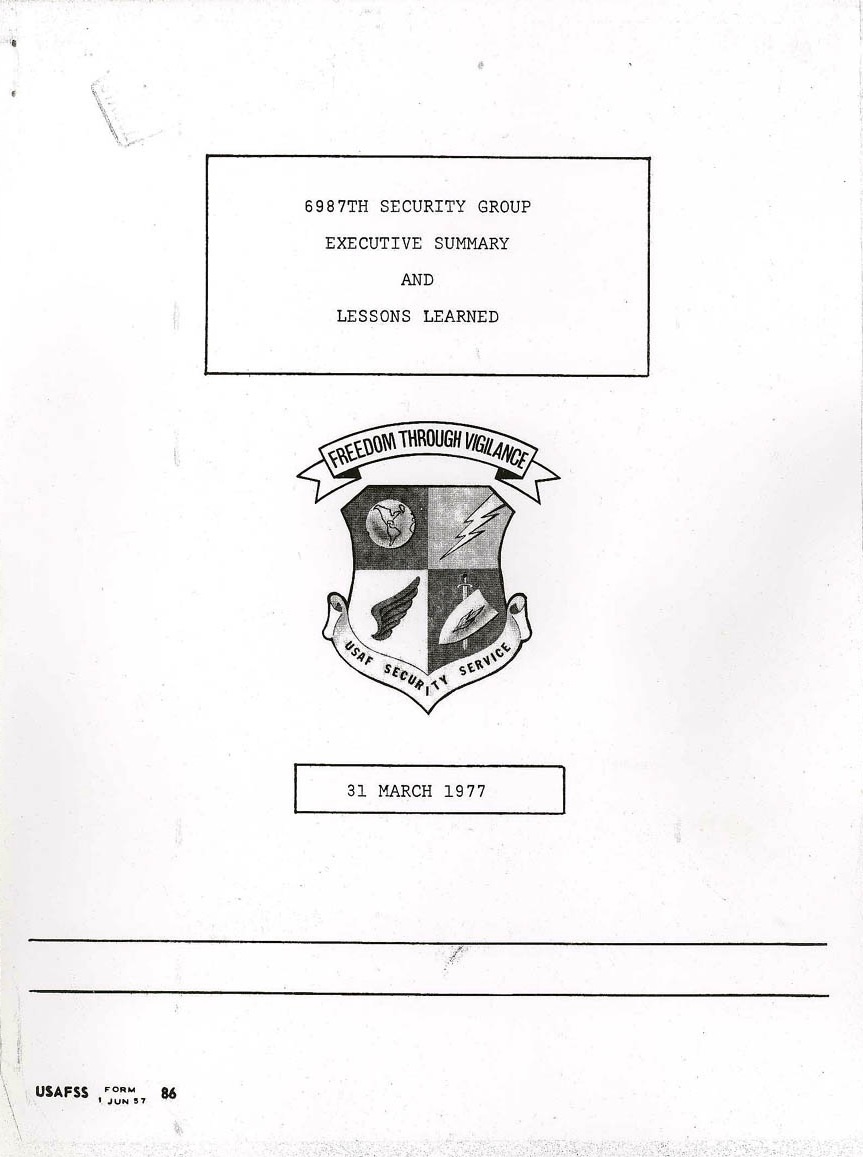
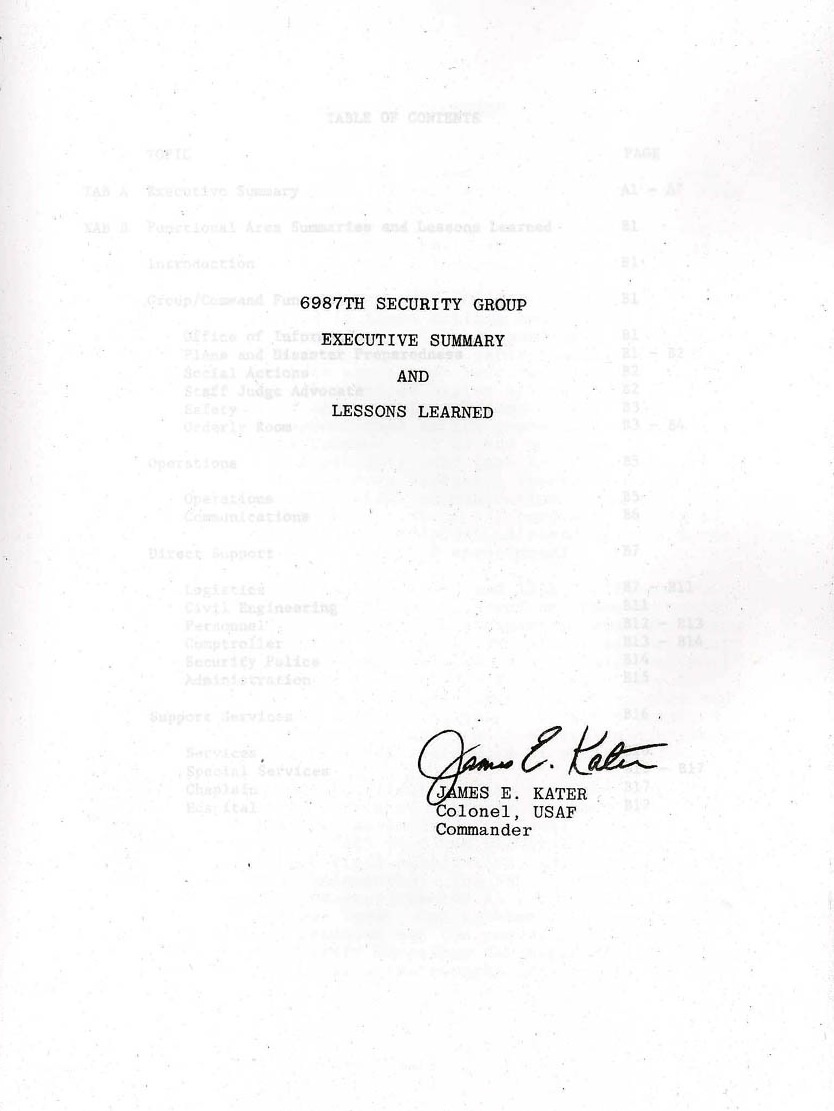
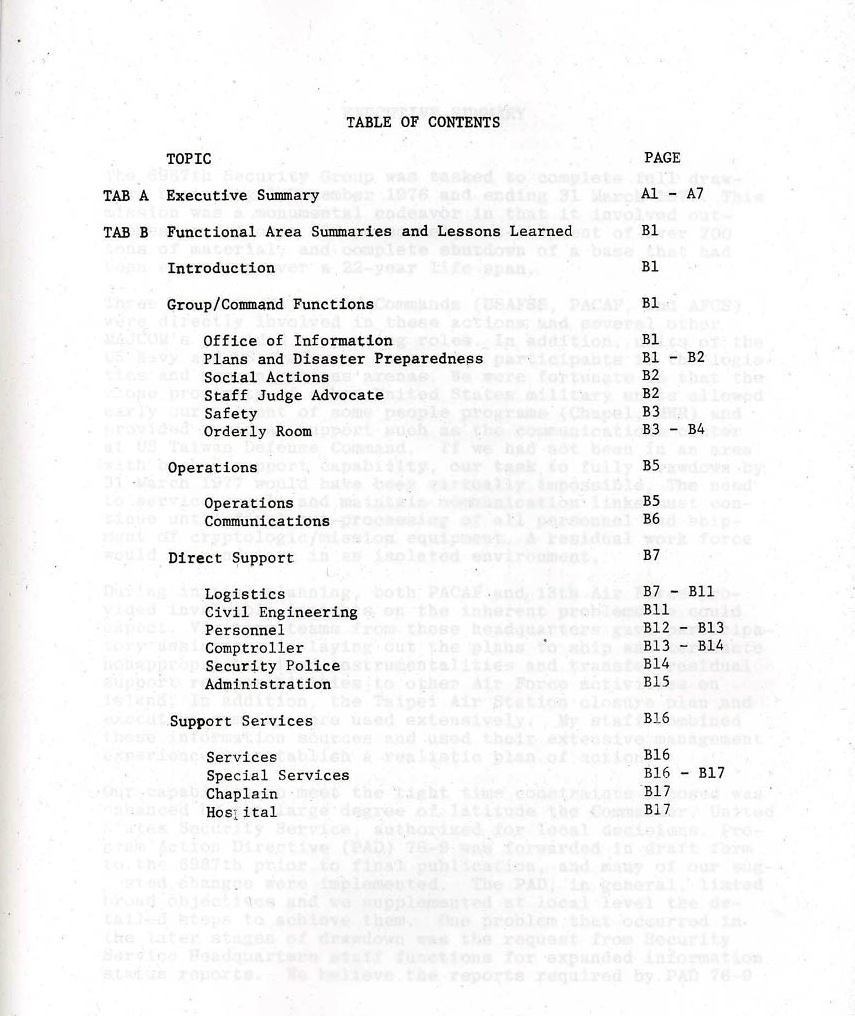
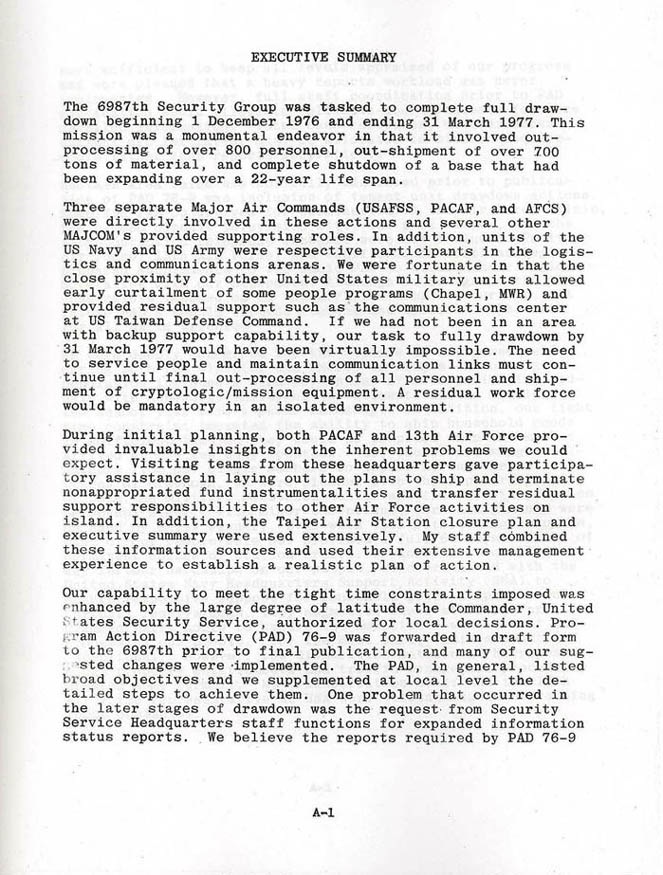
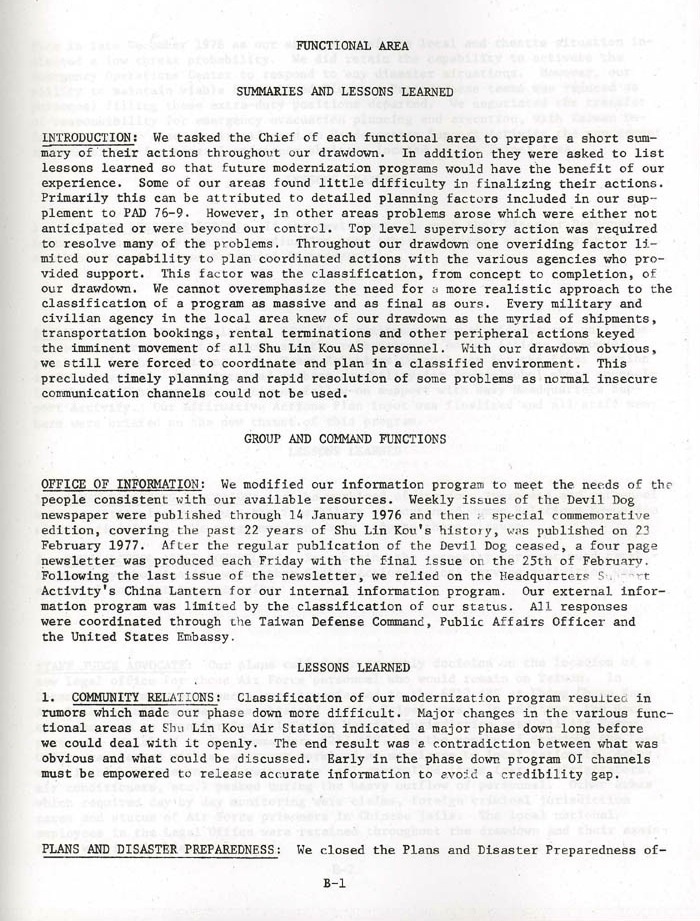
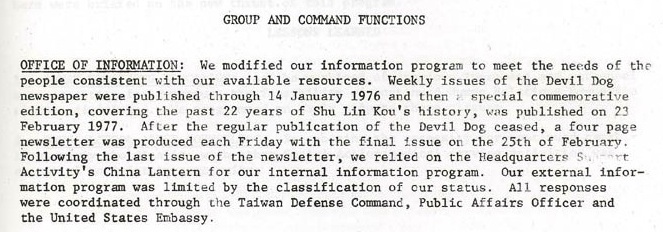 source: "6987th Security Group Executive Summary and Lessons Learned", 31 March 1977",
source: "6987th Security Group Executive Summary and Lessons Learned", 31 March 1977",
by Col James E. Kater, 6987th Group Commander, provided by Roger Jarvis (1975-77)
(Click on Images to Enlarge - to Zoom-in click again when open)
Colonel James E. Kater's, Commander 6987th Security Group, summary of the base closure and "lessons learned".
Included is information about the Shulinkou Devil Dog newspaper and its final commemorative issue (shown above).
Shulinkou Closes April 01, 1977
Ken Ashley (Dawg Flight: May 1974 to Feb 1977): "...We received word in October 1976 that the air station would be closing in early 1977." [11 Nov 2011]
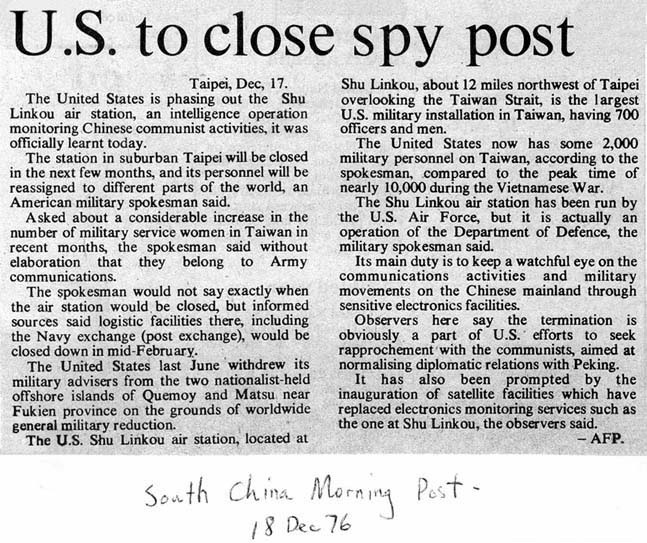

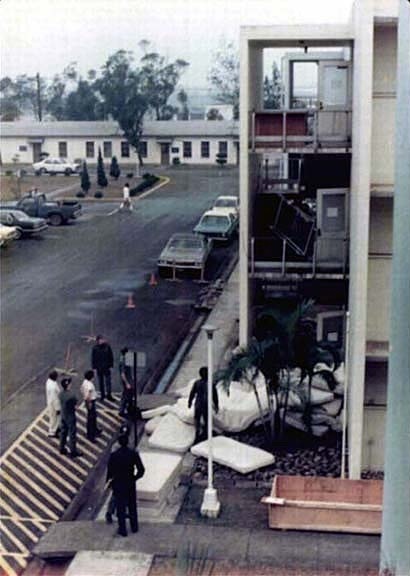 Photo credits: (1.) Hong Kong's South China Morning Post article provided by Les Duffin (2. & 3.) Al Budington (1976-77)
(Click on Images to Enlarge)
Photo credits: (1.) Hong Kong's South China Morning Post article provided by Les Duffin (2. & 3.) Al Budington (1976-77)
(Click on Images to Enlarge)
Shulinkou Air Station was deactivated and officially closed by the U.S. Air Force on April 01, 1977, 22 years after its establishment on February 16, 1955.
1.) December 18, 1976 article from the "Hong Kong South China Morning Post" regarding the upcoming closing of Shulinkou Air Station.
2.) Late March 1977 shot of the Operations Building, Compound, Gate Shack, and surrounding buildings on base prior to its closing on April 01, 1977. Shot taken from the Able Flight barracks' stairs.
3.) Late March 1977 photo showing everyone in the Dawg Flight (2nd floor), Charlie Flight (3rd Floor), and Baker Flight (1st floor) barracks "moving out" in early March 1977 prior to the base closing on April 01, 1977. The Operations Center (previous photo) is just off to the left across the street. (Shot taken from the Able Flight barracks stairs.)
Roger Jarvis (31 Mar 77): "We Were on the Last Aircraft of Air Force Personnel Out of the Country."
(Images on Right-Click to Enlarge) Roger Jarvis' Visa stamped "Departed March 31, 1977" at Taipei's Sungshan Air Base/Airport. images by Roger Jarvis
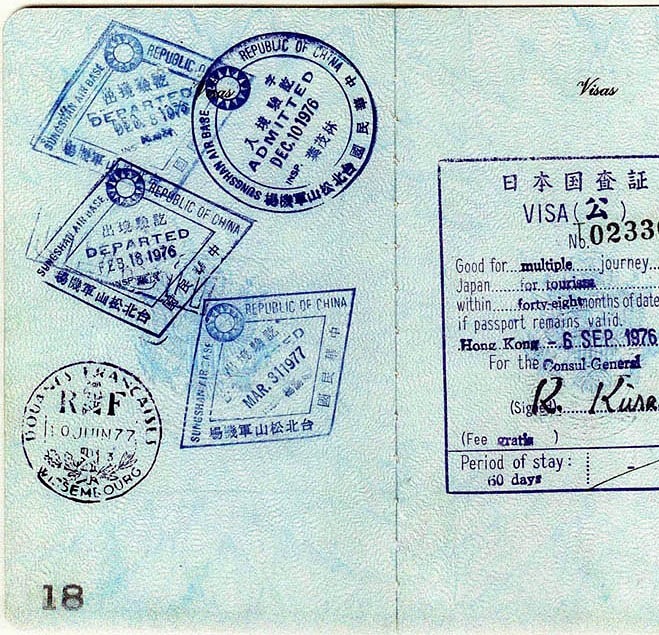
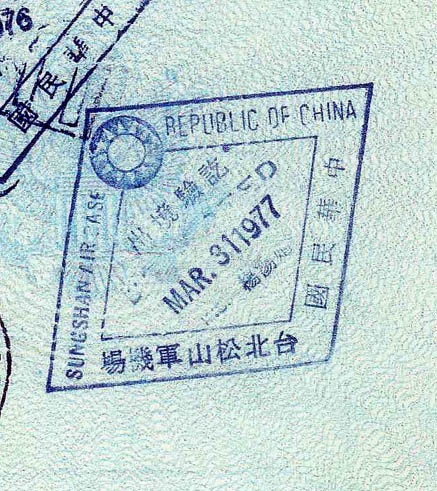 Roger Jarvis (1975-1977): "My wife, Katie, and I arrived at Shulinkou a couple months apart coming from Karamursel, Turkey, where we met and were married. I was a civilian employee (GS-11) and Katie was a USAFSS SSgt. 202X0 Communications Analyst. I administerted all the Base MWR programs. Katie and I were there until the base closed on 31 March 1977. We were on the last aircraft of Air Force personnel out of the country, as I recall (see images on right).
Roger Jarvis (1975-1977): "My wife, Katie, and I arrived at Shulinkou a couple months apart coming from Karamursel, Turkey, where we met and were married. I was a civilian employee (GS-11) and Katie was a USAFSS SSgt. 202X0 Communications Analyst. I administerted all the Base MWR programs. Katie and I were there until the base closed on 31 March 1977. We were on the last aircraft of Air Force personnel out of the country, as I recall (see images on right).
When I arrived in Sep 1975, Col James E. Kater, was the Shulinkou 6987th Group Commander, Lt. Col Jerome M. Wucher was Vice Group Commander, Lt. Col Carmen T. Scarpino was base commander, and Lt Col Cecil B. Fulford was Operations Commander. Lt. Colonel Scarpino departed in early spring 1977, a month or two before the closure. Colonel Kater departed just a few days before 31 March 77. Both departed before 31 March, as did all the other officers, except Major Tom Washington, Accounting and Finance officer. Major Washington took Command of Shulinkou in the final days. He departed on the aircraft we were all aboard on 31 March.
Katie and I were reassigned to the 6917th Security Group at San Vito, Italy where we remained until 1980. Katie then got out and went to Law School and we transferred to SAC at Offutt AFB. I left MWR and went into education and military training.
We have the fondest memories of Shulinkou. Beacause of my job I got to know just about everyone on the base. The highlight of my tour was the 1976 Bicentennial celebration, which my office put together. I most enjoyed Fast Pitch softball and we had a really great base team. Loved beating the Navy and Army teams and the Taiwanese collegiate teams down in Taipei. I think our '75 and '76 base teams beat just about everyone we played.
It was depressing those last three or four months becase we were tansferring everything to Clark AB, and as personnel began to depart it got pretty lonesome. I felt so bad for the Chinese and Taiwanese employees who worked at the base. I knew most all them. We had 32 civilian employees that worked in MWR. Leaving them behind with no jobs really bothered me for years." Roger and Katie Jarvis [15 Feb 2013]
Al High, from the "Early Days" at Linkou in 1955, to its closing in 1977
Al High was one of the first Air Force 203s at Shulinkou from 1955 to 1956 right after the base was first established and was in the Operations Center working for NSA as a civilian employee the day its operations ended, 22-years later.
Al High (1955-56): "...I forgot to add that I was present on the floor at Linkou the day that operations ceased [March 1977]. At that time, I was there TDY from NSA. Things had changed a bit from the 'Early Days' [1955-56]."
Jim Kubit (01 Apr 77): "I Took Down the Last Flag and Closed the Base."
Jim Kubit (1974-77): "I was with the Security Police Squadron at Shulinkou from July 1974 through its closing on April 01, 1977. I completed the last security police desk blotter, took down the base flag, and closed the main gate for the last time. There were some folks from Headquarters Support Activity (HSA) in Taipei and the Taiwan military present for the last retreat." (The desk blotter and flag were taken to HSA in Taipei for archival by the USAF.) [22 Dec 2001]
Jim Kubit (1974-77): "...I was the last Air Force troop stationed at Linkou. I took down the last flag, closed the base, and went down island to my new assignment at CCK Air Base in Taichung." [17 Aug 2012]

































































